Employee Engagement Welcomes the Dawn of an Empowerment Culture
VerifiedAdded on 2019/12/03
|23
|7545
|173
Literature Review
AI Summary
The provided content includes a range of academic texts on business research methods, strategy, leadership, management, and operations. The texts cover topics such as value chain analysis, sustainable value chains, strategic human resource management, monitoring and evaluation systems, employability skills, separation and reconnection in the strategic process, and risk management. The authors include Cooper and Schindler, Craig, Crain and Abraham, Dent, Dressler, Evans, Freeman, Gannon et al., García-Vázquez, Görgens-Albino and Kusek Z.J., Griffin and Annulis, Gustaf, Hill, Jeffs, Kale, Kaplan, Kimmel, Kumar, Lane, McBurney and White, Miguel and et. al., Plant, Sadler, Saunders and et. al., Sekhar, Thomas, Woods, and Zikmund and et. al.
Contribute Materials
Your contribution can guide someone’s learning journey. Share your
documents today.
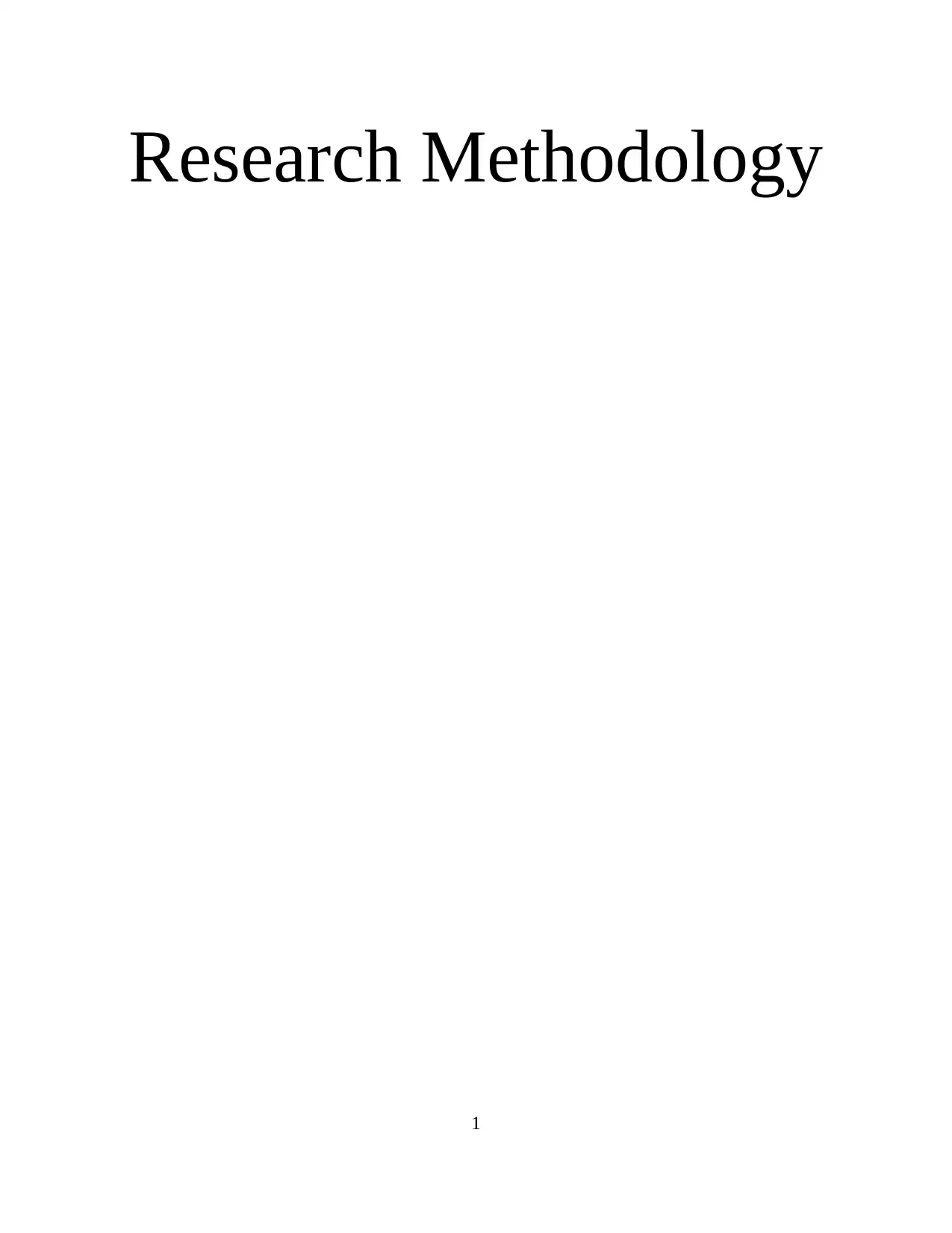
Research Methodology
1
1
Secure Best Marks with AI Grader
Need help grading? Try our AI Grader for instant feedback on your assignments.
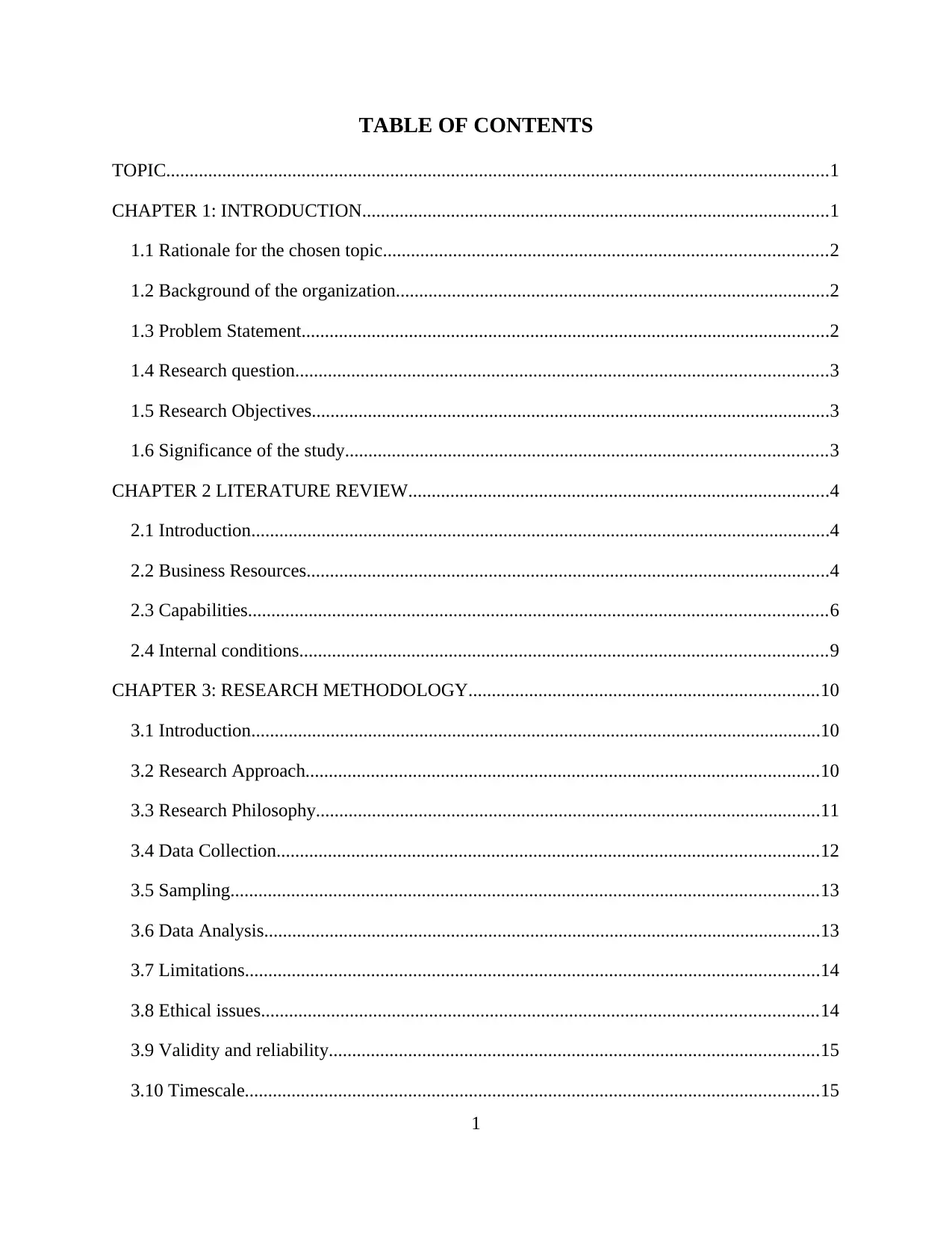
TABLE OF CONTENTS
TOPIC..............................................................................................................................................1
CHAPTER 1: INTRODUCTION....................................................................................................1
1.1 Rationale for the chosen topic...............................................................................................2
1.2 Background of the organization.............................................................................................2
1.3 Problem Statement.................................................................................................................2
1.4 Research question..................................................................................................................3
1.5 Research Objectives...............................................................................................................3
1.6 Significance of the study.......................................................................................................3
CHAPTER 2 LITERATURE REVIEW..........................................................................................4
2.1 Introduction............................................................................................................................4
2.2 Business Resources................................................................................................................4
2.3 Capabilities............................................................................................................................6
2.4 Internal conditions.................................................................................................................9
CHAPTER 3: RESEARCH METHODOLOGY...........................................................................10
3.1 Introduction..........................................................................................................................10
3.2 Research Approach..............................................................................................................10
3.3 Research Philosophy............................................................................................................11
3.4 Data Collection....................................................................................................................12
3.5 Sampling..............................................................................................................................13
3.6 Data Analysis.......................................................................................................................13
3.7 Limitations...........................................................................................................................14
3.8 Ethical issues.......................................................................................................................14
3.9 Validity and reliability.........................................................................................................15
3.10 Timescale...........................................................................................................................15
1
TOPIC..............................................................................................................................................1
CHAPTER 1: INTRODUCTION....................................................................................................1
1.1 Rationale for the chosen topic...............................................................................................2
1.2 Background of the organization.............................................................................................2
1.3 Problem Statement.................................................................................................................2
1.4 Research question..................................................................................................................3
1.5 Research Objectives...............................................................................................................3
1.6 Significance of the study.......................................................................................................3
CHAPTER 2 LITERATURE REVIEW..........................................................................................4
2.1 Introduction............................................................................................................................4
2.2 Business Resources................................................................................................................4
2.3 Capabilities............................................................................................................................6
2.4 Internal conditions.................................................................................................................9
CHAPTER 3: RESEARCH METHODOLOGY...........................................................................10
3.1 Introduction..........................................................................................................................10
3.2 Research Approach..............................................................................................................10
3.3 Research Philosophy............................................................................................................11
3.4 Data Collection....................................................................................................................12
3.5 Sampling..............................................................................................................................13
3.6 Data Analysis.......................................................................................................................13
3.7 Limitations...........................................................................................................................14
3.8 Ethical issues.......................................................................................................................14
3.9 Validity and reliability.........................................................................................................15
3.10 Timescale...........................................................................................................................15
1
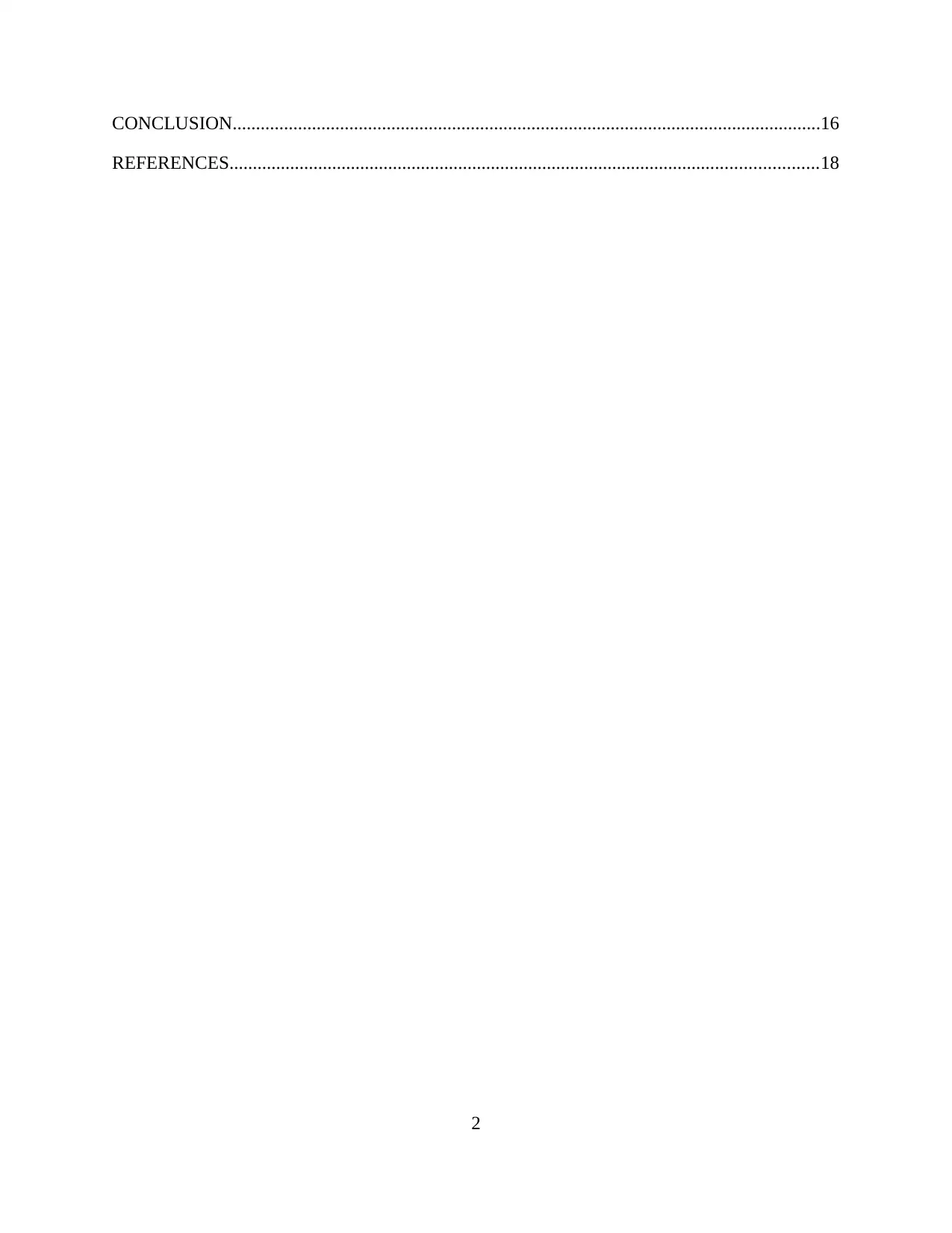
CONCLUSION..............................................................................................................................16
REFERENCES..............................................................................................................................18
2
REFERENCES..............................................................................................................................18
2
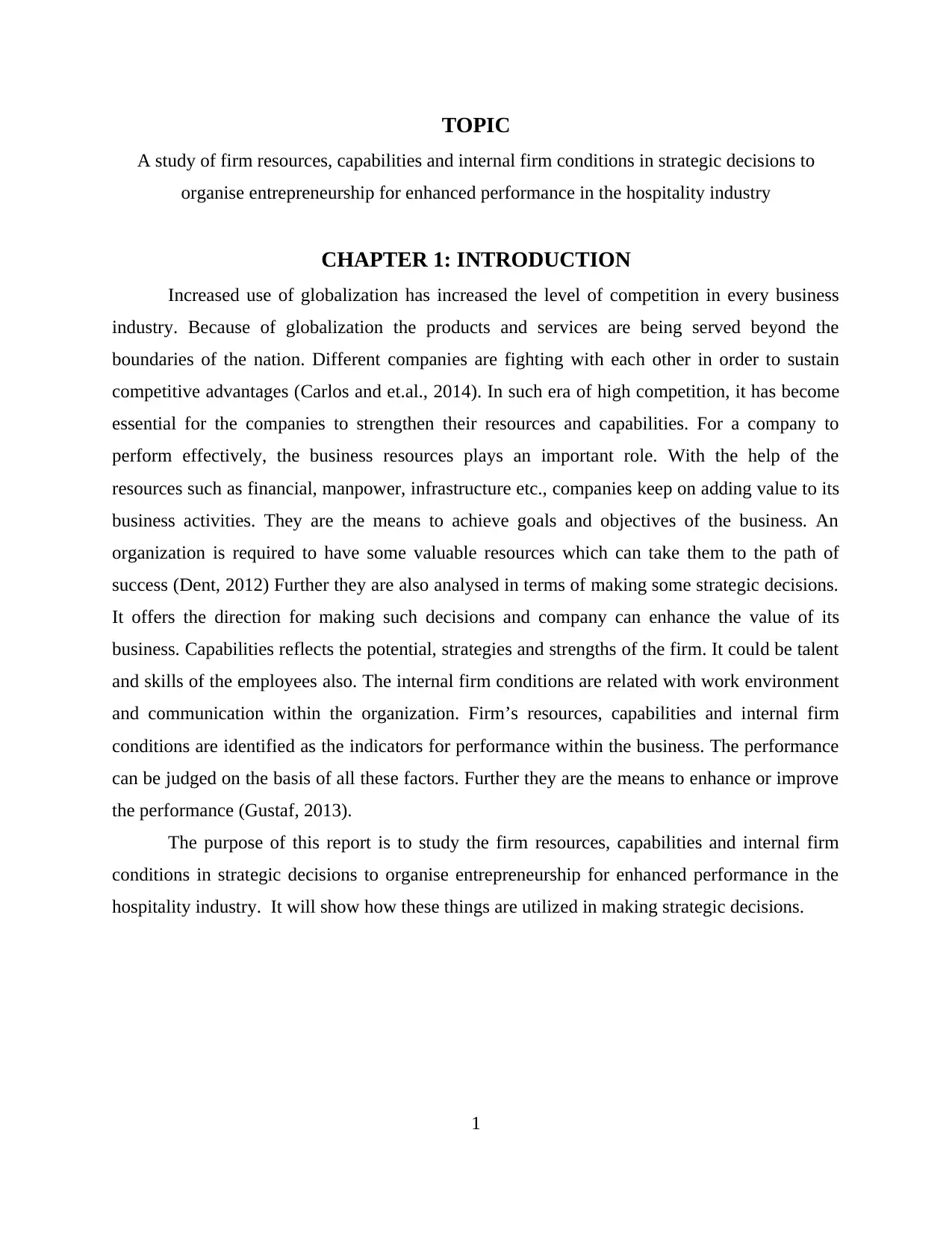
TOPIC
A study of firm resources, capabilities and internal firm conditions in strategic decisions to
organise entrepreneurship for enhanced performance in the hospitality industry
CHAPTER 1: INTRODUCTION
Increased use of globalization has increased the level of competition in every business
industry. Because of globalization the products and services are being served beyond the
boundaries of the nation. Different companies are fighting with each other in order to sustain
competitive advantages (Carlos and et.al., 2014). In such era of high competition, it has become
essential for the companies to strengthen their resources and capabilities. For a company to
perform effectively, the business resources plays an important role. With the help of the
resources such as financial, manpower, infrastructure etc., companies keep on adding value to its
business activities. They are the means to achieve goals and objectives of the business. An
organization is required to have some valuable resources which can take them to the path of
success (Dent, 2012) Further they are also analysed in terms of making some strategic decisions.
It offers the direction for making such decisions and company can enhance the value of its
business. Capabilities reflects the potential, strategies and strengths of the firm. It could be talent
and skills of the employees also. The internal firm conditions are related with work environment
and communication within the organization. Firm’s resources, capabilities and internal firm
conditions are identified as the indicators for performance within the business. The performance
can be judged on the basis of all these factors. Further they are the means to enhance or improve
the performance (Gustaf, 2013).
The purpose of this report is to study the firm resources, capabilities and internal firm
conditions in strategic decisions to organise entrepreneurship for enhanced performance in the
hospitality industry. It will show how these things are utilized in making strategic decisions.
1
A study of firm resources, capabilities and internal firm conditions in strategic decisions to
organise entrepreneurship for enhanced performance in the hospitality industry
CHAPTER 1: INTRODUCTION
Increased use of globalization has increased the level of competition in every business
industry. Because of globalization the products and services are being served beyond the
boundaries of the nation. Different companies are fighting with each other in order to sustain
competitive advantages (Carlos and et.al., 2014). In such era of high competition, it has become
essential for the companies to strengthen their resources and capabilities. For a company to
perform effectively, the business resources plays an important role. With the help of the
resources such as financial, manpower, infrastructure etc., companies keep on adding value to its
business activities. They are the means to achieve goals and objectives of the business. An
organization is required to have some valuable resources which can take them to the path of
success (Dent, 2012) Further they are also analysed in terms of making some strategic decisions.
It offers the direction for making such decisions and company can enhance the value of its
business. Capabilities reflects the potential, strategies and strengths of the firm. It could be talent
and skills of the employees also. The internal firm conditions are related with work environment
and communication within the organization. Firm’s resources, capabilities and internal firm
conditions are identified as the indicators for performance within the business. The performance
can be judged on the basis of all these factors. Further they are the means to enhance or improve
the performance (Gustaf, 2013).
The purpose of this report is to study the firm resources, capabilities and internal firm
conditions in strategic decisions to organise entrepreneurship for enhanced performance in the
hospitality industry. It will show how these things are utilized in making strategic decisions.
1
Secure Best Marks with AI Grader
Need help grading? Try our AI Grader for instant feedback on your assignments.
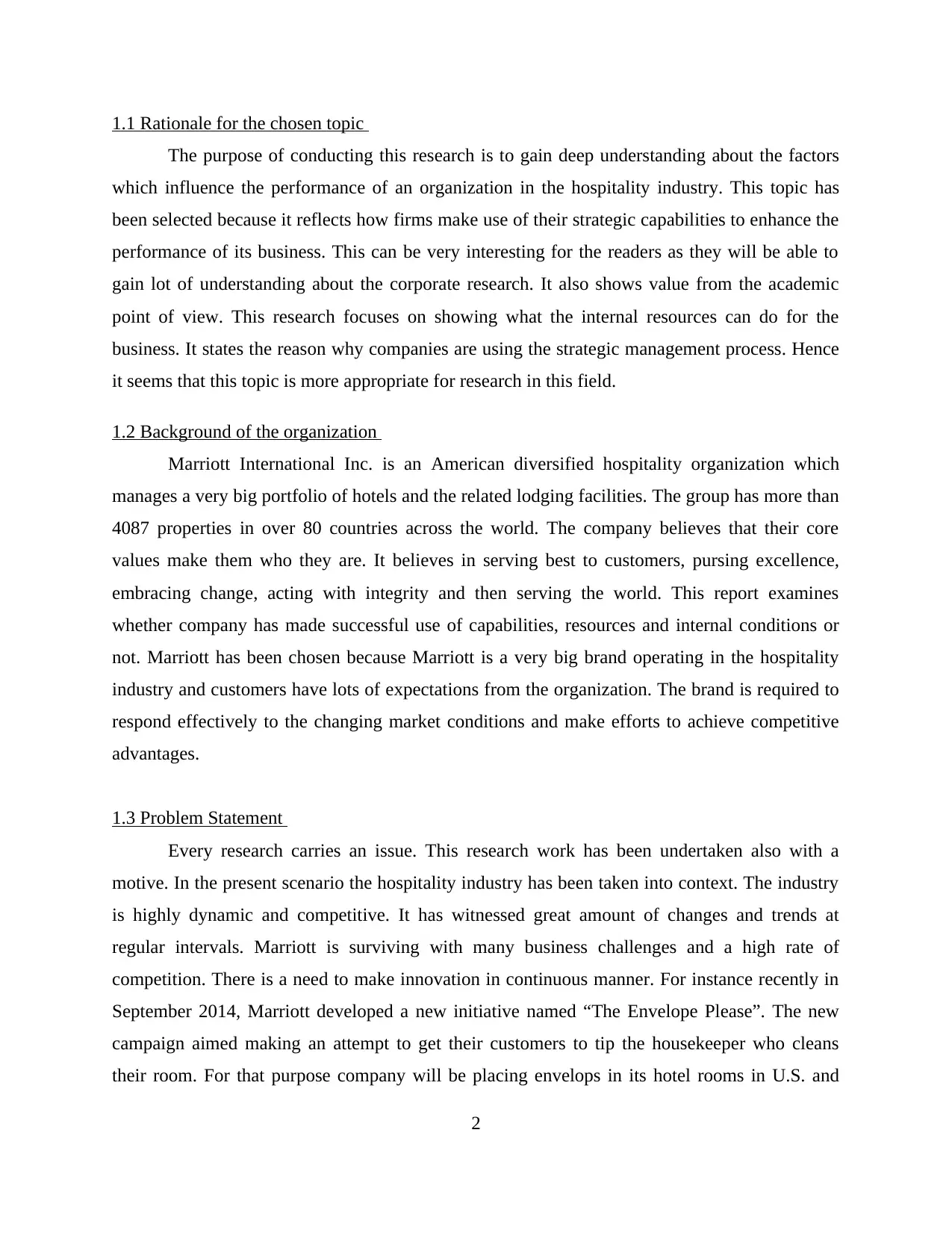
1.1 Rationale for the chosen topic
The purpose of conducting this research is to gain deep understanding about the factors
which influence the performance of an organization in the hospitality industry. This topic has
been selected because it reflects how firms make use of their strategic capabilities to enhance the
performance of its business. This can be very interesting for the readers as they will be able to
gain lot of understanding about the corporate research. It also shows value from the academic
point of view. This research focuses on showing what the internal resources can do for the
business. It states the reason why companies are using the strategic management process. Hence
it seems that this topic is more appropriate for research in this field.
1.2 Background of the organization
Marriott International Inc. is an American diversified hospitality organization which
manages a very big portfolio of hotels and the related lodging facilities. The group has more than
4087 properties in over 80 countries across the world. The company believes that their core
values make them who they are. It believes in serving best to customers, pursing excellence,
embracing change, acting with integrity and then serving the world. This report examines
whether company has made successful use of capabilities, resources and internal conditions or
not. Marriott has been chosen because Marriott is a very big brand operating in the hospitality
industry and customers have lots of expectations from the organization. The brand is required to
respond effectively to the changing market conditions and make efforts to achieve competitive
advantages.
1.3 Problem Statement
Every research carries an issue. This research work has been undertaken also with a
motive. In the present scenario the hospitality industry has been taken into context. The industry
is highly dynamic and competitive. It has witnessed great amount of changes and trends at
regular intervals. Marriott is surviving with many business challenges and a high rate of
competition. There is a need to make innovation in continuous manner. For instance recently in
September 2014, Marriott developed a new initiative named “The Envelope Please”. The new
campaign aimed making an attempt to get their customers to tip the housekeeper who cleans
their room. For that purpose company will be placing envelops in its hotel rooms in U.S. and
2
The purpose of conducting this research is to gain deep understanding about the factors
which influence the performance of an organization in the hospitality industry. This topic has
been selected because it reflects how firms make use of their strategic capabilities to enhance the
performance of its business. This can be very interesting for the readers as they will be able to
gain lot of understanding about the corporate research. It also shows value from the academic
point of view. This research focuses on showing what the internal resources can do for the
business. It states the reason why companies are using the strategic management process. Hence
it seems that this topic is more appropriate for research in this field.
1.2 Background of the organization
Marriott International Inc. is an American diversified hospitality organization which
manages a very big portfolio of hotels and the related lodging facilities. The group has more than
4087 properties in over 80 countries across the world. The company believes that their core
values make them who they are. It believes in serving best to customers, pursing excellence,
embracing change, acting with integrity and then serving the world. This report examines
whether company has made successful use of capabilities, resources and internal conditions or
not. Marriott has been chosen because Marriott is a very big brand operating in the hospitality
industry and customers have lots of expectations from the organization. The brand is required to
respond effectively to the changing market conditions and make efforts to achieve competitive
advantages.
1.3 Problem Statement
Every research carries an issue. This research work has been undertaken also with a
motive. In the present scenario the hospitality industry has been taken into context. The industry
is highly dynamic and competitive. It has witnessed great amount of changes and trends at
regular intervals. Marriott is surviving with many business challenges and a high rate of
competition. There is a need to make innovation in continuous manner. For instance recently in
September 2014, Marriott developed a new initiative named “The Envelope Please”. The new
campaign aimed making an attempt to get their customers to tip the housekeeper who cleans
their room. For that purpose company will be placing envelops in its hotel rooms in U.S. and
2
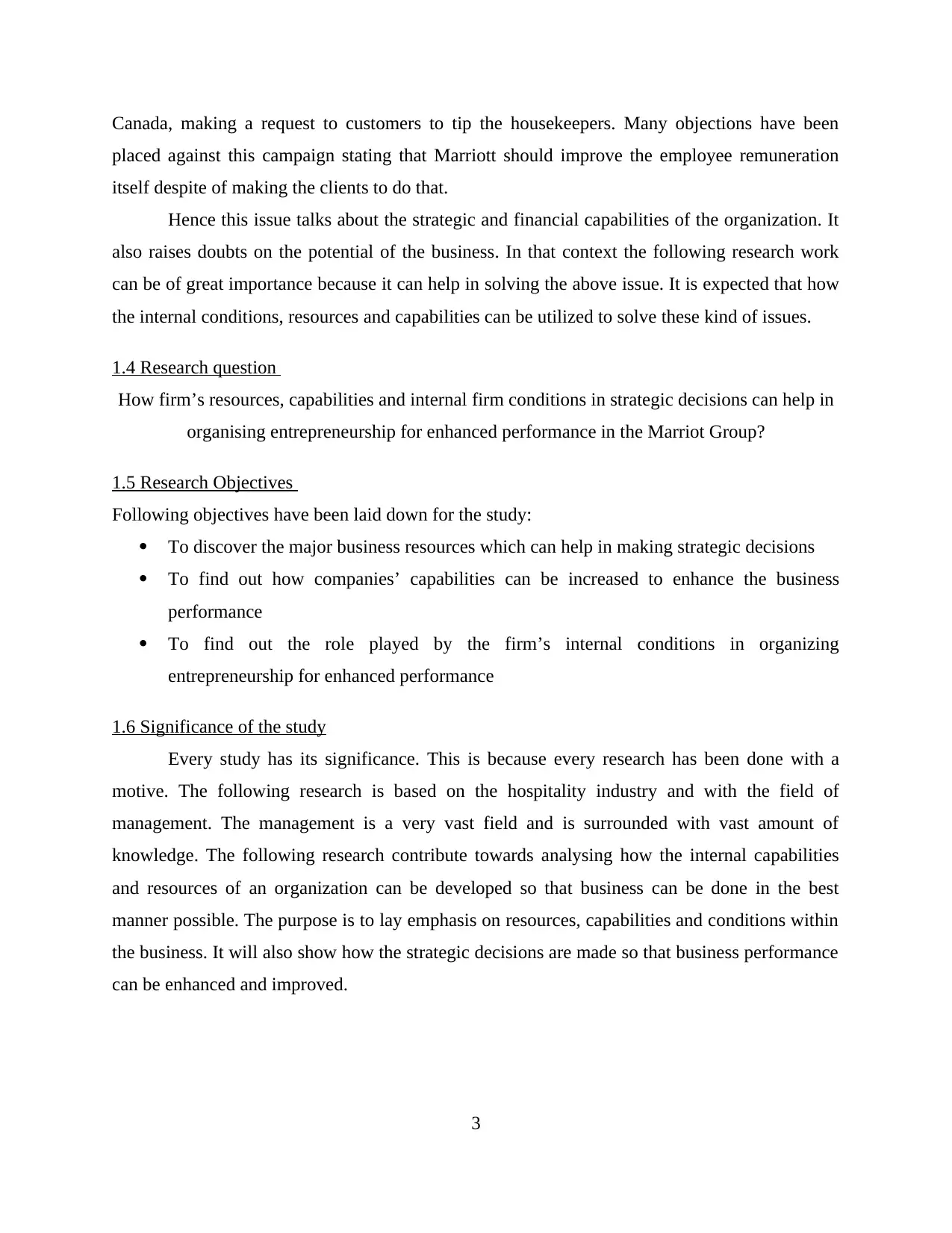
Canada, making a request to customers to tip the housekeepers. Many objections have been
placed against this campaign stating that Marriott should improve the employee remuneration
itself despite of making the clients to do that.
Hence this issue talks about the strategic and financial capabilities of the organization. It
also raises doubts on the potential of the business. In that context the following research work
can be of great importance because it can help in solving the above issue. It is expected that how
the internal conditions, resources and capabilities can be utilized to solve these kind of issues.
1.4 Research question
How firm’s resources, capabilities and internal firm conditions in strategic decisions can help in
organising entrepreneurship for enhanced performance in the Marriot Group?
1.5 Research Objectives
Following objectives have been laid down for the study:
To discover the major business resources which can help in making strategic decisions
To find out how companies’ capabilities can be increased to enhance the business
performance
To find out the role played by the firm’s internal conditions in organizing
entrepreneurship for enhanced performance
1.6 Significance of the study
Every study has its significance. This is because every research has been done with a
motive. The following research is based on the hospitality industry and with the field of
management. The management is a very vast field and is surrounded with vast amount of
knowledge. The following research contribute towards analysing how the internal capabilities
and resources of an organization can be developed so that business can be done in the best
manner possible. The purpose is to lay emphasis on resources, capabilities and conditions within
the business. It will also show how the strategic decisions are made so that business performance
can be enhanced and improved.
3
placed against this campaign stating that Marriott should improve the employee remuneration
itself despite of making the clients to do that.
Hence this issue talks about the strategic and financial capabilities of the organization. It
also raises doubts on the potential of the business. In that context the following research work
can be of great importance because it can help in solving the above issue. It is expected that how
the internal conditions, resources and capabilities can be utilized to solve these kind of issues.
1.4 Research question
How firm’s resources, capabilities and internal firm conditions in strategic decisions can help in
organising entrepreneurship for enhanced performance in the Marriot Group?
1.5 Research Objectives
Following objectives have been laid down for the study:
To discover the major business resources which can help in making strategic decisions
To find out how companies’ capabilities can be increased to enhance the business
performance
To find out the role played by the firm’s internal conditions in organizing
entrepreneurship for enhanced performance
1.6 Significance of the study
Every study has its significance. This is because every research has been done with a
motive. The following research is based on the hospitality industry and with the field of
management. The management is a very vast field and is surrounded with vast amount of
knowledge. The following research contribute towards analysing how the internal capabilities
and resources of an organization can be developed so that business can be done in the best
manner possible. The purpose is to lay emphasis on resources, capabilities and conditions within
the business. It will also show how the strategic decisions are made so that business performance
can be enhanced and improved.
3
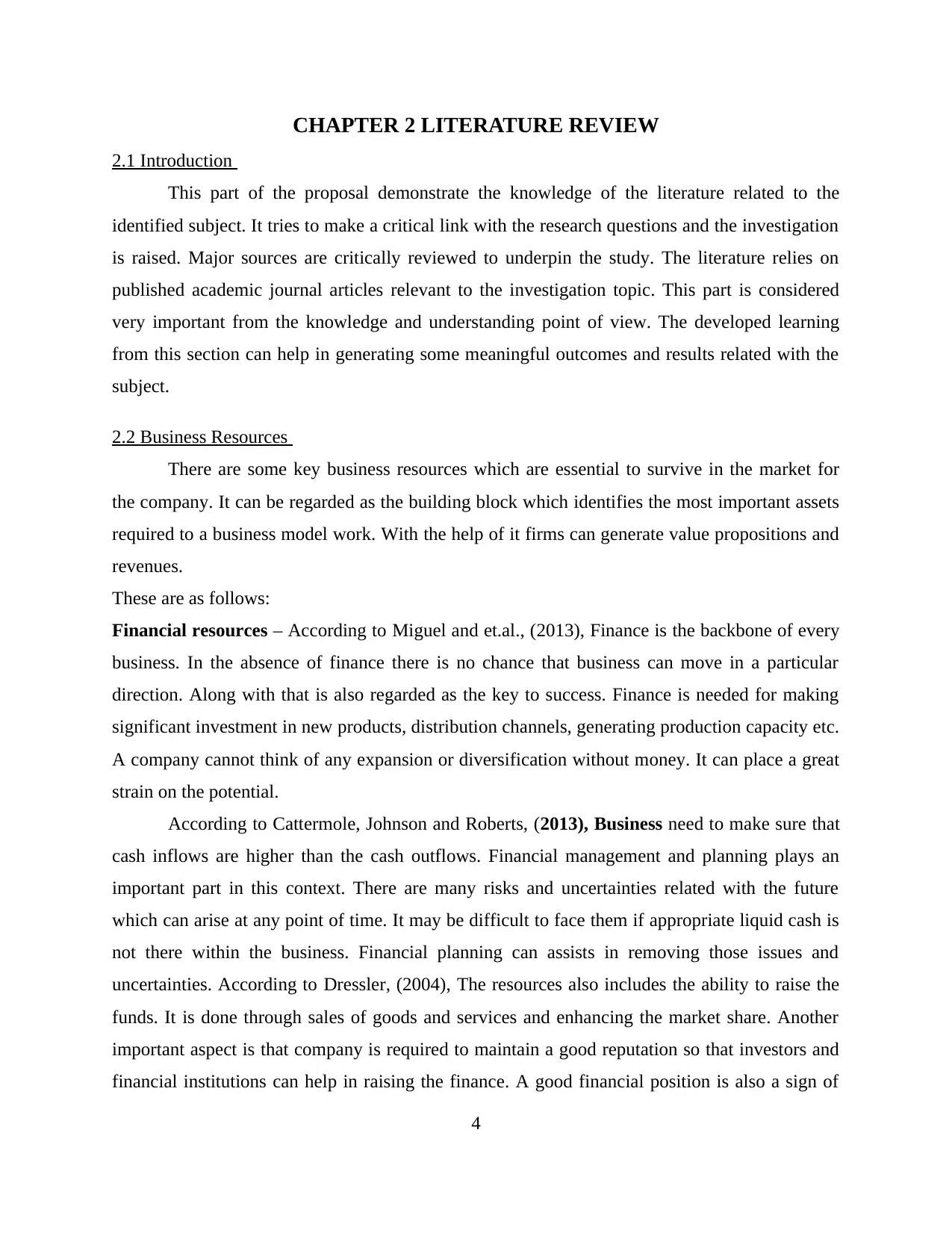
CHAPTER 2 LITERATURE REVIEW
2.1 Introduction
This part of the proposal demonstrate the knowledge of the literature related to the
identified subject. It tries to make a critical link with the research questions and the investigation
is raised. Major sources are critically reviewed to underpin the study. The literature relies on
published academic journal articles relevant to the investigation topic. This part is considered
very important from the knowledge and understanding point of view. The developed learning
from this section can help in generating some meaningful outcomes and results related with the
subject.
2.2 Business Resources
There are some key business resources which are essential to survive in the market for
the company. It can be regarded as the building block which identifies the most important assets
required to a business model work. With the help of it firms can generate value propositions and
revenues.
These are as follows:
Financial resources – According to Miguel and et.al., (2013), Finance is the backbone of every
business. In the absence of finance there is no chance that business can move in a particular
direction. Along with that is also regarded as the key to success. Finance is needed for making
significant investment in new products, distribution channels, generating production capacity etc.
A company cannot think of any expansion or diversification without money. It can place a great
strain on the potential.
According to Cattermole, Johnson and Roberts, (2013), Business need to make sure that
cash inflows are higher than the cash outflows. Financial management and planning plays an
important part in this context. There are many risks and uncertainties related with the future
which can arise at any point of time. It may be difficult to face them if appropriate liquid cash is
not there within the business. Financial planning can assists in removing those issues and
uncertainties. According to Dressler, (2004), The resources also includes the ability to raise the
funds. It is done through sales of goods and services and enhancing the market share. Another
important aspect is that company is required to maintain a good reputation so that investors and
financial institutions can help in raising the finance. A good financial position is also a sign of
4
2.1 Introduction
This part of the proposal demonstrate the knowledge of the literature related to the
identified subject. It tries to make a critical link with the research questions and the investigation
is raised. Major sources are critically reviewed to underpin the study. The literature relies on
published academic journal articles relevant to the investigation topic. This part is considered
very important from the knowledge and understanding point of view. The developed learning
from this section can help in generating some meaningful outcomes and results related with the
subject.
2.2 Business Resources
There are some key business resources which are essential to survive in the market for
the company. It can be regarded as the building block which identifies the most important assets
required to a business model work. With the help of it firms can generate value propositions and
revenues.
These are as follows:
Financial resources – According to Miguel and et.al., (2013), Finance is the backbone of every
business. In the absence of finance there is no chance that business can move in a particular
direction. Along with that is also regarded as the key to success. Finance is needed for making
significant investment in new products, distribution channels, generating production capacity etc.
A company cannot think of any expansion or diversification without money. It can place a great
strain on the potential.
According to Cattermole, Johnson and Roberts, (2013), Business need to make sure that
cash inflows are higher than the cash outflows. Financial management and planning plays an
important part in this context. There are many risks and uncertainties related with the future
which can arise at any point of time. It may be difficult to face them if appropriate liquid cash is
not there within the business. Financial planning can assists in removing those issues and
uncertainties. According to Dressler, (2004), The resources also includes the ability to raise the
funds. It is done through sales of goods and services and enhancing the market share. Another
important aspect is that company is required to maintain a good reputation so that investors and
financial institutions can help in raising the finance. A good financial position is also a sign of
4
Paraphrase This Document
Need a fresh take? Get an instant paraphrase of this document with our AI Paraphraser
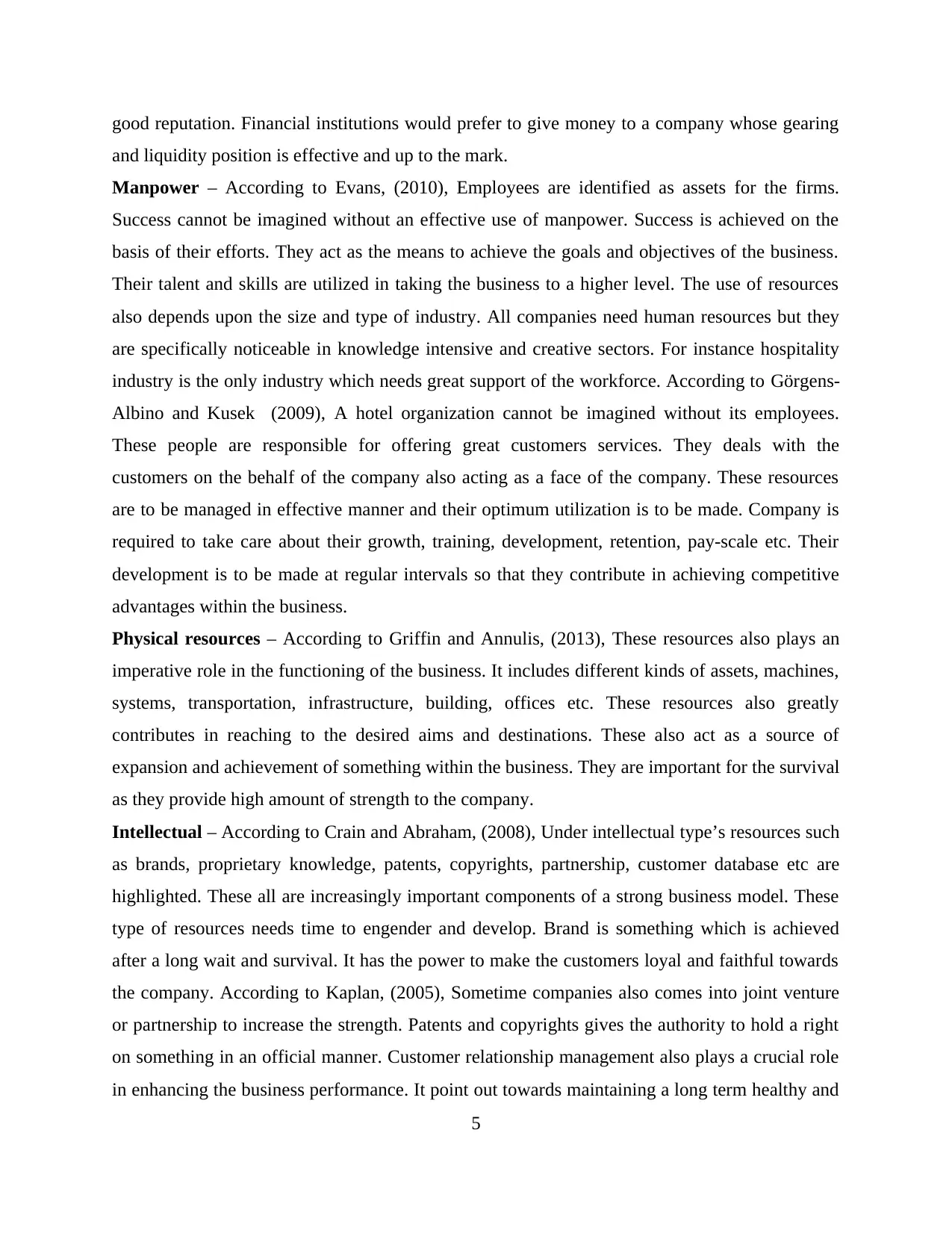
good reputation. Financial institutions would prefer to give money to a company whose gearing
and liquidity position is effective and up to the mark.
Manpower – According to Evans, (2010), Employees are identified as assets for the firms.
Success cannot be imagined without an effective use of manpower. Success is achieved on the
basis of their efforts. They act as the means to achieve the goals and objectives of the business.
Their talent and skills are utilized in taking the business to a higher level. The use of resources
also depends upon the size and type of industry. All companies need human resources but they
are specifically noticeable in knowledge intensive and creative sectors. For instance hospitality
industry is the only industry which needs great support of the workforce. According to Görgens-
Albino and Kusek (2009), A hotel organization cannot be imagined without its employees.
These people are responsible for offering great customers services. They deals with the
customers on the behalf of the company also acting as a face of the company. These resources
are to be managed in effective manner and their optimum utilization is to be made. Company is
required to take care about their growth, training, development, retention, pay-scale etc. Their
development is to be made at regular intervals so that they contribute in achieving competitive
advantages within the business.
Physical resources – According to Griffin and Annulis, (2013), These resources also plays an
imperative role in the functioning of the business. It includes different kinds of assets, machines,
systems, transportation, infrastructure, building, offices etc. These resources also greatly
contributes in reaching to the desired aims and destinations. These also act as a source of
expansion and achievement of something within the business. They are important for the survival
as they provide high amount of strength to the company.
Intellectual – According to Crain and Abraham, (2008), Under intellectual type’s resources such
as brands, proprietary knowledge, patents, copyrights, partnership, customer database etc are
highlighted. These all are increasingly important components of a strong business model. These
type of resources needs time to engender and develop. Brand is something which is achieved
after a long wait and survival. It has the power to make the customers loyal and faithful towards
the company. According to Kaplan, (2005), Sometime companies also comes into joint venture
or partnership to increase the strength. Patents and copyrights gives the authority to hold a right
on something in an official manner. Customer relationship management also plays a crucial role
in enhancing the business performance. It point out towards maintaining a long term healthy and
5
and liquidity position is effective and up to the mark.
Manpower – According to Evans, (2010), Employees are identified as assets for the firms.
Success cannot be imagined without an effective use of manpower. Success is achieved on the
basis of their efforts. They act as the means to achieve the goals and objectives of the business.
Their talent and skills are utilized in taking the business to a higher level. The use of resources
also depends upon the size and type of industry. All companies need human resources but they
are specifically noticeable in knowledge intensive and creative sectors. For instance hospitality
industry is the only industry which needs great support of the workforce. According to Görgens-
Albino and Kusek (2009), A hotel organization cannot be imagined without its employees.
These people are responsible for offering great customers services. They deals with the
customers on the behalf of the company also acting as a face of the company. These resources
are to be managed in effective manner and their optimum utilization is to be made. Company is
required to take care about their growth, training, development, retention, pay-scale etc. Their
development is to be made at regular intervals so that they contribute in achieving competitive
advantages within the business.
Physical resources – According to Griffin and Annulis, (2013), These resources also plays an
imperative role in the functioning of the business. It includes different kinds of assets, machines,
systems, transportation, infrastructure, building, offices etc. These resources also greatly
contributes in reaching to the desired aims and destinations. These also act as a source of
expansion and achievement of something within the business. They are important for the survival
as they provide high amount of strength to the company.
Intellectual – According to Crain and Abraham, (2008), Under intellectual type’s resources such
as brands, proprietary knowledge, patents, copyrights, partnership, customer database etc are
highlighted. These all are increasingly important components of a strong business model. These
type of resources needs time to engender and develop. Brand is something which is achieved
after a long wait and survival. It has the power to make the customers loyal and faithful towards
the company. According to Kaplan, (2005), Sometime companies also comes into joint venture
or partnership to increase the strength. Patents and copyrights gives the authority to hold a right
on something in an official manner. Customer relationship management also plays a crucial role
in enhancing the business performance. It point out towards maintaining a long term healthy and
5
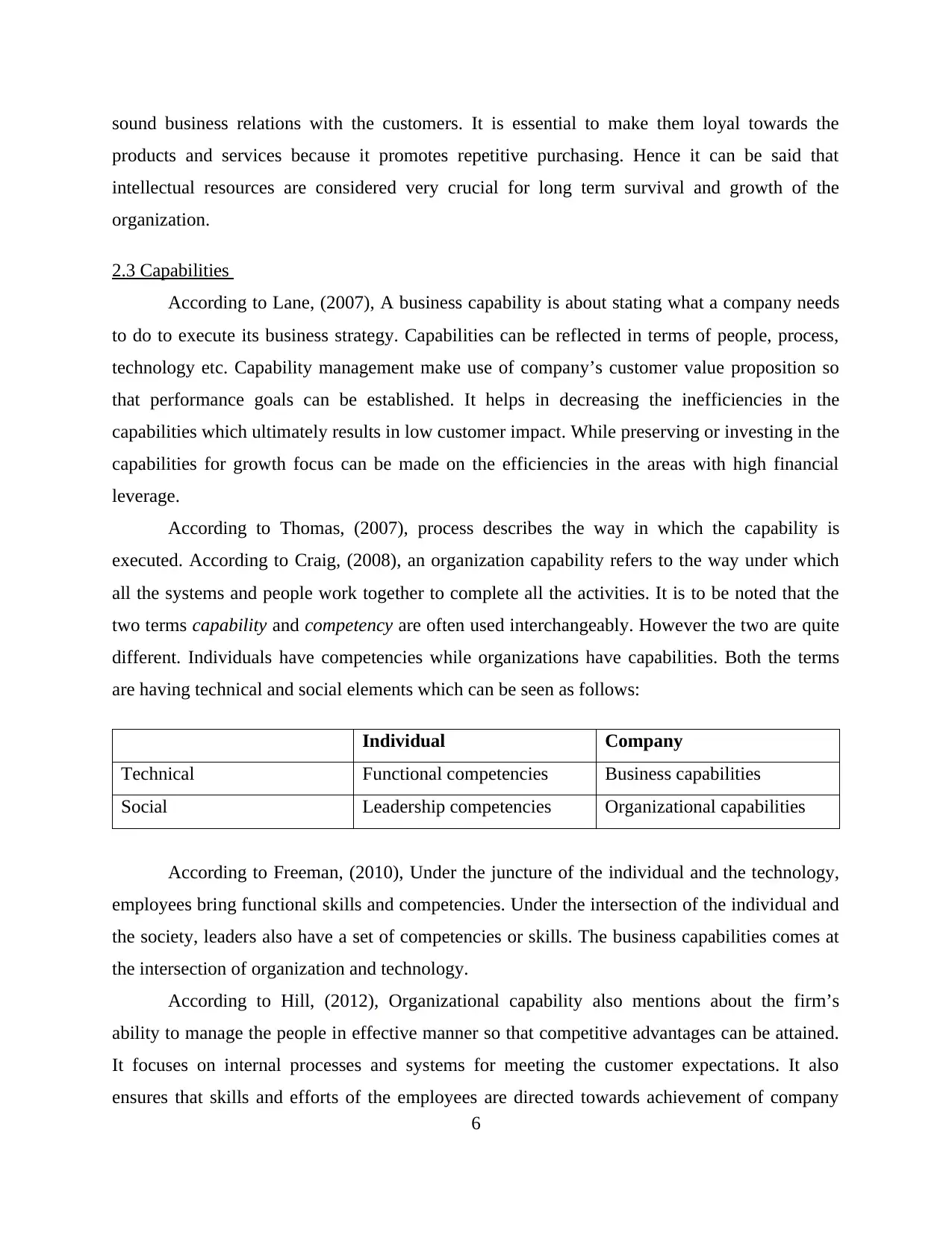
sound business relations with the customers. It is essential to make them loyal towards the
products and services because it promotes repetitive purchasing. Hence it can be said that
intellectual resources are considered very crucial for long term survival and growth of the
organization.
2.3 Capabilities
According to Lane, (2007), A business capability is about stating what a company needs
to do to execute its business strategy. Capabilities can be reflected in terms of people, process,
technology etc. Capability management make use of company’s customer value proposition so
that performance goals can be established. It helps in decreasing the inefficiencies in the
capabilities which ultimately results in low customer impact. While preserving or investing in the
capabilities for growth focus can be made on the efficiencies in the areas with high financial
leverage.
According to Thomas, (2007), process describes the way in which the capability is
executed. According to Craig, (2008), an organization capability refers to the way under which
all the systems and people work together to complete all the activities. It is to be noted that the
two terms capability and competency are often used interchangeably. However the two are quite
different. Individuals have competencies while organizations have capabilities. Both the terms
are having technical and social elements which can be seen as follows:
Individual Company
Technical Functional competencies Business capabilities
Social Leadership competencies Organizational capabilities
According to Freeman, (2010), Under the juncture of the individual and the technology,
employees bring functional skills and competencies. Under the intersection of the individual and
the society, leaders also have a set of competencies or skills. The business capabilities comes at
the intersection of organization and technology.
According to Hill, (2012), Organizational capability also mentions about the firm’s
ability to manage the people in effective manner so that competitive advantages can be attained.
It focuses on internal processes and systems for meeting the customer expectations. It also
ensures that skills and efforts of the employees are directed towards achievement of company
6
products and services because it promotes repetitive purchasing. Hence it can be said that
intellectual resources are considered very crucial for long term survival and growth of the
organization.
2.3 Capabilities
According to Lane, (2007), A business capability is about stating what a company needs
to do to execute its business strategy. Capabilities can be reflected in terms of people, process,
technology etc. Capability management make use of company’s customer value proposition so
that performance goals can be established. It helps in decreasing the inefficiencies in the
capabilities which ultimately results in low customer impact. While preserving or investing in the
capabilities for growth focus can be made on the efficiencies in the areas with high financial
leverage.
According to Thomas, (2007), process describes the way in which the capability is
executed. According to Craig, (2008), an organization capability refers to the way under which
all the systems and people work together to complete all the activities. It is to be noted that the
two terms capability and competency are often used interchangeably. However the two are quite
different. Individuals have competencies while organizations have capabilities. Both the terms
are having technical and social elements which can be seen as follows:
Individual Company
Technical Functional competencies Business capabilities
Social Leadership competencies Organizational capabilities
According to Freeman, (2010), Under the juncture of the individual and the technology,
employees bring functional skills and competencies. Under the intersection of the individual and
the society, leaders also have a set of competencies or skills. The business capabilities comes at
the intersection of organization and technology.
According to Hill, (2012), Organizational capability also mentions about the firm’s
ability to manage the people in effective manner so that competitive advantages can be attained.
It focuses on internal processes and systems for meeting the customer expectations. It also
ensures that skills and efforts of the employees are directed towards achievement of company
6
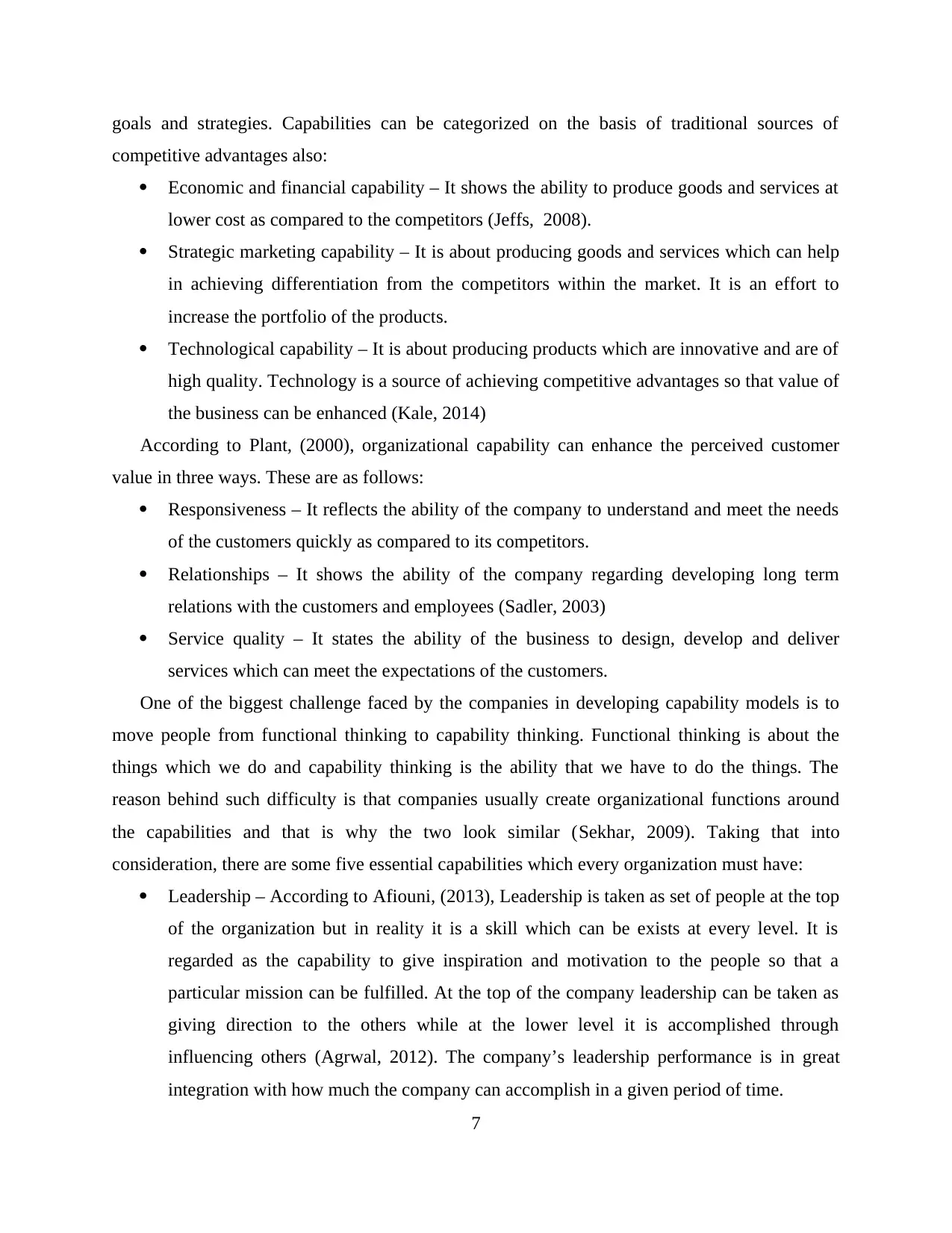
goals and strategies. Capabilities can be categorized on the basis of traditional sources of
competitive advantages also:
Economic and financial capability – It shows the ability to produce goods and services at
lower cost as compared to the competitors (Jeffs, 2008).
Strategic marketing capability – It is about producing goods and services which can help
in achieving differentiation from the competitors within the market. It is an effort to
increase the portfolio of the products.
Technological capability – It is about producing products which are innovative and are of
high quality. Technology is a source of achieving competitive advantages so that value of
the business can be enhanced (Kale, 2014)
According to Plant, (2000), organizational capability can enhance the perceived customer
value in three ways. These are as follows:
Responsiveness – It reflects the ability of the company to understand and meet the needs
of the customers quickly as compared to its competitors.
Relationships – It shows the ability of the company regarding developing long term
relations with the customers and employees (Sadler, 2003)
Service quality – It states the ability of the business to design, develop and deliver
services which can meet the expectations of the customers.
One of the biggest challenge faced by the companies in developing capability models is to
move people from functional thinking to capability thinking. Functional thinking is about the
things which we do and capability thinking is the ability that we have to do the things. The
reason behind such difficulty is that companies usually create organizational functions around
the capabilities and that is why the two look similar (Sekhar, 2009). Taking that into
consideration, there are some five essential capabilities which every organization must have:
Leadership – According to Afiouni, (2013), Leadership is taken as set of people at the top
of the organization but in reality it is a skill which can be exists at every level. It is
regarded as the capability to give inspiration and motivation to the people so that a
particular mission can be fulfilled. At the top of the company leadership can be taken as
giving direction to the others while at the lower level it is accomplished through
influencing others (Agrwal, 2012). The company’s leadership performance is in great
integration with how much the company can accomplish in a given period of time.
7
competitive advantages also:
Economic and financial capability – It shows the ability to produce goods and services at
lower cost as compared to the competitors (Jeffs, 2008).
Strategic marketing capability – It is about producing goods and services which can help
in achieving differentiation from the competitors within the market. It is an effort to
increase the portfolio of the products.
Technological capability – It is about producing products which are innovative and are of
high quality. Technology is a source of achieving competitive advantages so that value of
the business can be enhanced (Kale, 2014)
According to Plant, (2000), organizational capability can enhance the perceived customer
value in three ways. These are as follows:
Responsiveness – It reflects the ability of the company to understand and meet the needs
of the customers quickly as compared to its competitors.
Relationships – It shows the ability of the company regarding developing long term
relations with the customers and employees (Sadler, 2003)
Service quality – It states the ability of the business to design, develop and deliver
services which can meet the expectations of the customers.
One of the biggest challenge faced by the companies in developing capability models is to
move people from functional thinking to capability thinking. Functional thinking is about the
things which we do and capability thinking is the ability that we have to do the things. The
reason behind such difficulty is that companies usually create organizational functions around
the capabilities and that is why the two look similar (Sekhar, 2009). Taking that into
consideration, there are some five essential capabilities which every organization must have:
Leadership – According to Afiouni, (2013), Leadership is taken as set of people at the top
of the organization but in reality it is a skill which can be exists at every level. It is
regarded as the capability to give inspiration and motivation to the people so that a
particular mission can be fulfilled. At the top of the company leadership can be taken as
giving direction to the others while at the lower level it is accomplished through
influencing others (Agrwal, 2012). The company’s leadership performance is in great
integration with how much the company can accomplish in a given period of time.
7
Secure Best Marks with AI Grader
Need help grading? Try our AI Grader for instant feedback on your assignments.
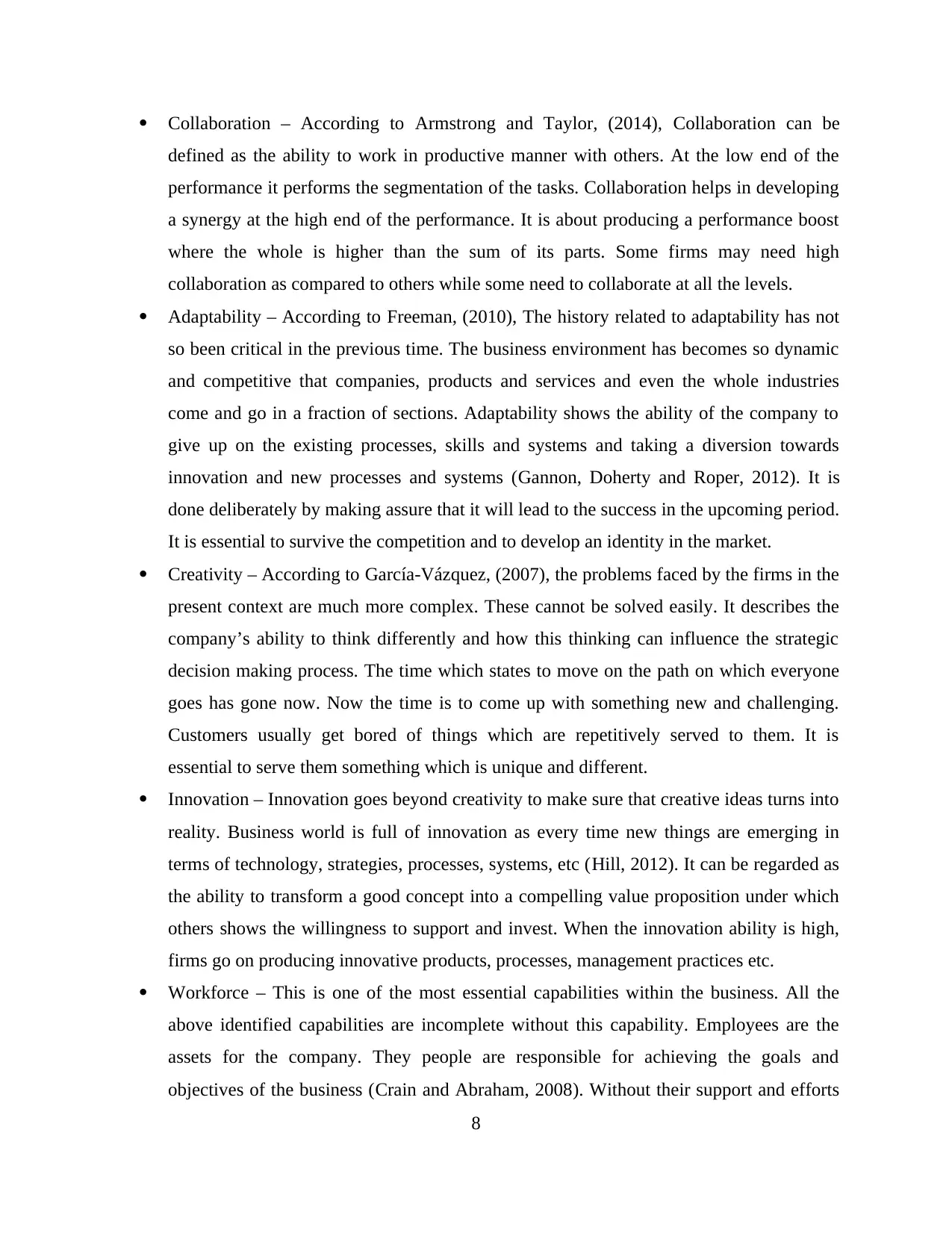
Collaboration – According to Armstrong and Taylor, (2014), Collaboration can be
defined as the ability to work in productive manner with others. At the low end of the
performance it performs the segmentation of the tasks. Collaboration helps in developing
a synergy at the high end of the performance. It is about producing a performance boost
where the whole is higher than the sum of its parts. Some firms may need high
collaboration as compared to others while some need to collaborate at all the levels.
Adaptability – According to Freeman, (2010), The history related to adaptability has not
so been critical in the previous time. The business environment has becomes so dynamic
and competitive that companies, products and services and even the whole industries
come and go in a fraction of sections. Adaptability shows the ability of the company to
give up on the existing processes, skills and systems and taking a diversion towards
innovation and new processes and systems (Gannon, Doherty and Roper, 2012). It is
done deliberately by making assure that it will lead to the success in the upcoming period.
It is essential to survive the competition and to develop an identity in the market.
Creativity – According to García-Vázquez, (2007), the problems faced by the firms in the
present context are much more complex. These cannot be solved easily. It describes the
company’s ability to think differently and how this thinking can influence the strategic
decision making process. The time which states to move on the path on which everyone
goes has gone now. Now the time is to come up with something new and challenging.
Customers usually get bored of things which are repetitively served to them. It is
essential to serve them something which is unique and different.
Innovation – Innovation goes beyond creativity to make sure that creative ideas turns into
reality. Business world is full of innovation as every time new things are emerging in
terms of technology, strategies, processes, systems, etc (Hill, 2012). It can be regarded as
the ability to transform a good concept into a compelling value proposition under which
others shows the willingness to support and invest. When the innovation ability is high,
firms go on producing innovative products, processes, management practices etc.
Workforce – This is one of the most essential capabilities within the business. All the
above identified capabilities are incomplete without this capability. Employees are the
assets for the company. They people are responsible for achieving the goals and
objectives of the business (Crain and Abraham, 2008). Without their support and efforts
8
defined as the ability to work in productive manner with others. At the low end of the
performance it performs the segmentation of the tasks. Collaboration helps in developing
a synergy at the high end of the performance. It is about producing a performance boost
where the whole is higher than the sum of its parts. Some firms may need high
collaboration as compared to others while some need to collaborate at all the levels.
Adaptability – According to Freeman, (2010), The history related to adaptability has not
so been critical in the previous time. The business environment has becomes so dynamic
and competitive that companies, products and services and even the whole industries
come and go in a fraction of sections. Adaptability shows the ability of the company to
give up on the existing processes, skills and systems and taking a diversion towards
innovation and new processes and systems (Gannon, Doherty and Roper, 2012). It is
done deliberately by making assure that it will lead to the success in the upcoming period.
It is essential to survive the competition and to develop an identity in the market.
Creativity – According to García-Vázquez, (2007), the problems faced by the firms in the
present context are much more complex. These cannot be solved easily. It describes the
company’s ability to think differently and how this thinking can influence the strategic
decision making process. The time which states to move on the path on which everyone
goes has gone now. Now the time is to come up with something new and challenging.
Customers usually get bored of things which are repetitively served to them. It is
essential to serve them something which is unique and different.
Innovation – Innovation goes beyond creativity to make sure that creative ideas turns into
reality. Business world is full of innovation as every time new things are emerging in
terms of technology, strategies, processes, systems, etc (Hill, 2012). It can be regarded as
the ability to transform a good concept into a compelling value proposition under which
others shows the willingness to support and invest. When the innovation ability is high,
firms go on producing innovative products, processes, management practices etc.
Workforce – This is one of the most essential capabilities within the business. All the
above identified capabilities are incomplete without this capability. Employees are the
assets for the company. They people are responsible for achieving the goals and
objectives of the business (Crain and Abraham, 2008). Without their support and efforts
8
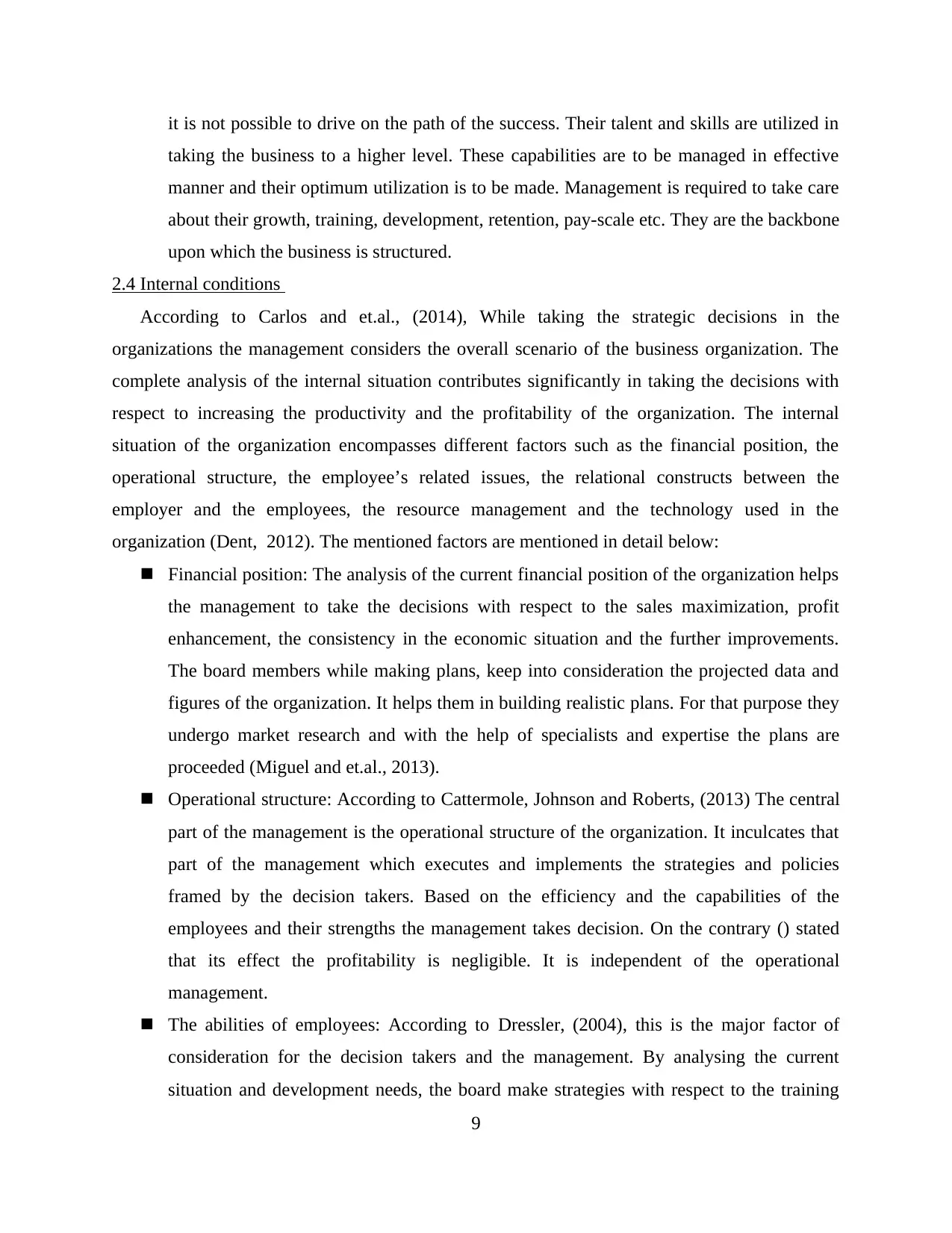
it is not possible to drive on the path of the success. Their talent and skills are utilized in
taking the business to a higher level. These capabilities are to be managed in effective
manner and their optimum utilization is to be made. Management is required to take care
about their growth, training, development, retention, pay-scale etc. They are the backbone
upon which the business is structured.
2.4 Internal conditions
According to Carlos and et.al., (2014), While taking the strategic decisions in the
organizations the management considers the overall scenario of the business organization. The
complete analysis of the internal situation contributes significantly in taking the decisions with
respect to increasing the productivity and the profitability of the organization. The internal
situation of the organization encompasses different factors such as the financial position, the
operational structure, the employee’s related issues, the relational constructs between the
employer and the employees, the resource management and the technology used in the
organization (Dent, 2012). The mentioned factors are mentioned in detail below:
Financial position: The analysis of the current financial position of the organization helps
the management to take the decisions with respect to the sales maximization, profit
enhancement, the consistency in the economic situation and the further improvements.
The board members while making plans, keep into consideration the projected data and
figures of the organization. It helps them in building realistic plans. For that purpose they
undergo market research and with the help of specialists and expertise the plans are
proceeded (Miguel and et.al., 2013).
Operational structure: According to Cattermole, Johnson and Roberts, (2013) The central
part of the management is the operational structure of the organization. It inculcates that
part of the management which executes and implements the strategies and policies
framed by the decision takers. Based on the efficiency and the capabilities of the
employees and their strengths the management takes decision. On the contrary () stated
that its effect the profitability is negligible. It is independent of the operational
management.
The abilities of employees: According to Dressler, (2004), this is the major factor of
consideration for the decision takers and the management. By analysing the current
situation and development needs, the board make strategies with respect to the training
9
taking the business to a higher level. These capabilities are to be managed in effective
manner and their optimum utilization is to be made. Management is required to take care
about their growth, training, development, retention, pay-scale etc. They are the backbone
upon which the business is structured.
2.4 Internal conditions
According to Carlos and et.al., (2014), While taking the strategic decisions in the
organizations the management considers the overall scenario of the business organization. The
complete analysis of the internal situation contributes significantly in taking the decisions with
respect to increasing the productivity and the profitability of the organization. The internal
situation of the organization encompasses different factors such as the financial position, the
operational structure, the employee’s related issues, the relational constructs between the
employer and the employees, the resource management and the technology used in the
organization (Dent, 2012). The mentioned factors are mentioned in detail below:
Financial position: The analysis of the current financial position of the organization helps
the management to take the decisions with respect to the sales maximization, profit
enhancement, the consistency in the economic situation and the further improvements.
The board members while making plans, keep into consideration the projected data and
figures of the organization. It helps them in building realistic plans. For that purpose they
undergo market research and with the help of specialists and expertise the plans are
proceeded (Miguel and et.al., 2013).
Operational structure: According to Cattermole, Johnson and Roberts, (2013) The central
part of the management is the operational structure of the organization. It inculcates that
part of the management which executes and implements the strategies and policies
framed by the decision takers. Based on the efficiency and the capabilities of the
employees and their strengths the management takes decision. On the contrary () stated
that its effect the profitability is negligible. It is independent of the operational
management.
The abilities of employees: According to Dressler, (2004), this is the major factor of
consideration for the decision takers and the management. By analysing the current
situation and development needs, the board make strategies with respect to the training
9
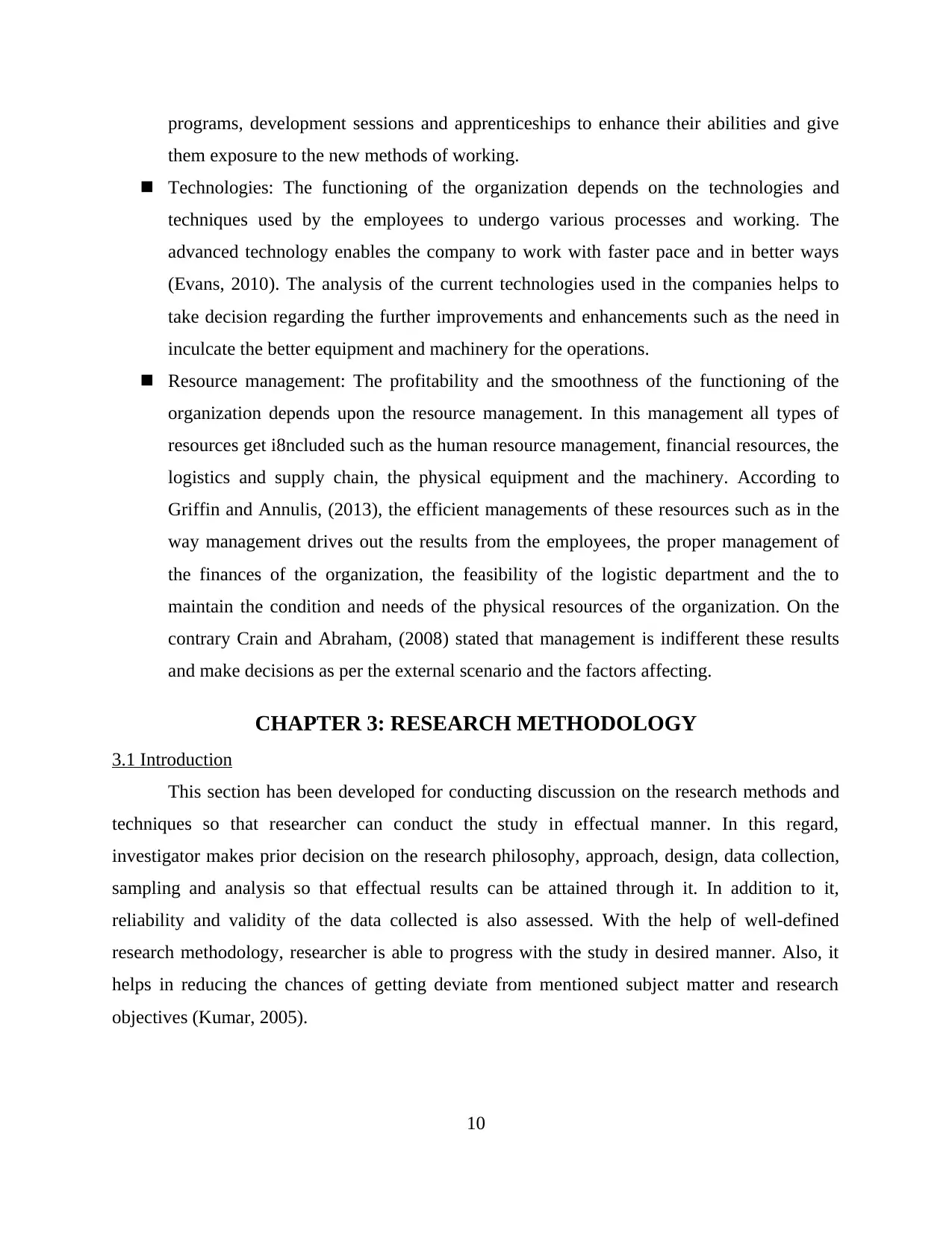
programs, development sessions and apprenticeships to enhance their abilities and give
them exposure to the new methods of working.
Technologies: The functioning of the organization depends on the technologies and
techniques used by the employees to undergo various processes and working. The
advanced technology enables the company to work with faster pace and in better ways
(Evans, 2010). The analysis of the current technologies used in the companies helps to
take decision regarding the further improvements and enhancements such as the need in
inculcate the better equipment and machinery for the operations.
Resource management: The profitability and the smoothness of the functioning of the
organization depends upon the resource management. In this management all types of
resources get i8ncluded such as the human resource management, financial resources, the
logistics and supply chain, the physical equipment and the machinery. According to
Griffin and Annulis, (2013), the efficient managements of these resources such as in the
way management drives out the results from the employees, the proper management of
the finances of the organization, the feasibility of the logistic department and the to
maintain the condition and needs of the physical resources of the organization. On the
contrary Crain and Abraham, (2008) stated that management is indifferent these results
and make decisions as per the external scenario and the factors affecting.
CHAPTER 3: RESEARCH METHODOLOGY
3.1 Introduction
This section has been developed for conducting discussion on the research methods and
techniques so that researcher can conduct the study in effectual manner. In this regard,
investigator makes prior decision on the research philosophy, approach, design, data collection,
sampling and analysis so that effectual results can be attained through it. In addition to it,
reliability and validity of the data collected is also assessed. With the help of well-defined
research methodology, researcher is able to progress with the study in desired manner. Also, it
helps in reducing the chances of getting deviate from mentioned subject matter and research
objectives (Kumar, 2005).
10
them exposure to the new methods of working.
Technologies: The functioning of the organization depends on the technologies and
techniques used by the employees to undergo various processes and working. The
advanced technology enables the company to work with faster pace and in better ways
(Evans, 2010). The analysis of the current technologies used in the companies helps to
take decision regarding the further improvements and enhancements such as the need in
inculcate the better equipment and machinery for the operations.
Resource management: The profitability and the smoothness of the functioning of the
organization depends upon the resource management. In this management all types of
resources get i8ncluded such as the human resource management, financial resources, the
logistics and supply chain, the physical equipment and the machinery. According to
Griffin and Annulis, (2013), the efficient managements of these resources such as in the
way management drives out the results from the employees, the proper management of
the finances of the organization, the feasibility of the logistic department and the to
maintain the condition and needs of the physical resources of the organization. On the
contrary Crain and Abraham, (2008) stated that management is indifferent these results
and make decisions as per the external scenario and the factors affecting.
CHAPTER 3: RESEARCH METHODOLOGY
3.1 Introduction
This section has been developed for conducting discussion on the research methods and
techniques so that researcher can conduct the study in effectual manner. In this regard,
investigator makes prior decision on the research philosophy, approach, design, data collection,
sampling and analysis so that effectual results can be attained through it. In addition to it,
reliability and validity of the data collected is also assessed. With the help of well-defined
research methodology, researcher is able to progress with the study in desired manner. Also, it
helps in reducing the chances of getting deviate from mentioned subject matter and research
objectives (Kumar, 2005).
10
Paraphrase This Document
Need a fresh take? Get an instant paraphrase of this document with our AI Paraphraser
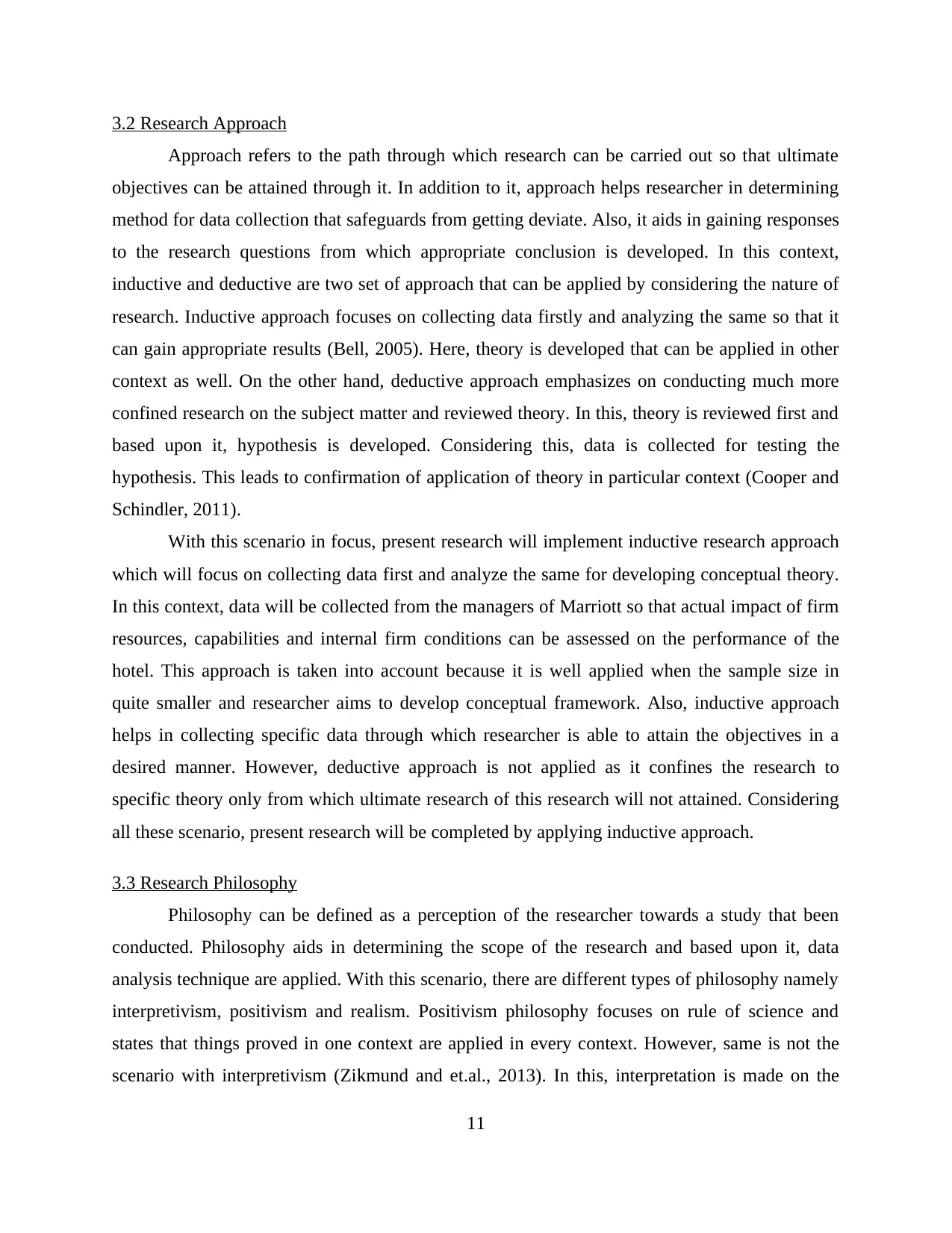
3.2 Research Approach
Approach refers to the path through which research can be carried out so that ultimate
objectives can be attained through it. In addition to it, approach helps researcher in determining
method for data collection that safeguards from getting deviate. Also, it aids in gaining responses
to the research questions from which appropriate conclusion is developed. In this context,
inductive and deductive are two set of approach that can be applied by considering the nature of
research. Inductive approach focuses on collecting data firstly and analyzing the same so that it
can gain appropriate results (Bell, 2005). Here, theory is developed that can be applied in other
context as well. On the other hand, deductive approach emphasizes on conducting much more
confined research on the subject matter and reviewed theory. In this, theory is reviewed first and
based upon it, hypothesis is developed. Considering this, data is collected for testing the
hypothesis. This leads to confirmation of application of theory in particular context (Cooper and
Schindler, 2011).
With this scenario in focus, present research will implement inductive research approach
which will focus on collecting data first and analyze the same for developing conceptual theory.
In this context, data will be collected from the managers of Marriott so that actual impact of firm
resources, capabilities and internal firm conditions can be assessed on the performance of the
hotel. This approach is taken into account because it is well applied when the sample size in
quite smaller and researcher aims to develop conceptual framework. Also, inductive approach
helps in collecting specific data through which researcher is able to attain the objectives in a
desired manner. However, deductive approach is not applied as it confines the research to
specific theory only from which ultimate research of this research will not attained. Considering
all these scenario, present research will be completed by applying inductive approach.
3.3 Research Philosophy
Philosophy can be defined as a perception of the researcher towards a study that been
conducted. Philosophy aids in determining the scope of the research and based upon it, data
analysis technique are applied. With this scenario, there are different types of philosophy namely
interpretivism, positivism and realism. Positivism philosophy focuses on rule of science and
states that things proved in one context are applied in every context. However, same is not the
scenario with interpretivism (Zikmund and et.al., 2013). In this, interpretation is made on the
11
Approach refers to the path through which research can be carried out so that ultimate
objectives can be attained through it. In addition to it, approach helps researcher in determining
method for data collection that safeguards from getting deviate. Also, it aids in gaining responses
to the research questions from which appropriate conclusion is developed. In this context,
inductive and deductive are two set of approach that can be applied by considering the nature of
research. Inductive approach focuses on collecting data firstly and analyzing the same so that it
can gain appropriate results (Bell, 2005). Here, theory is developed that can be applied in other
context as well. On the other hand, deductive approach emphasizes on conducting much more
confined research on the subject matter and reviewed theory. In this, theory is reviewed first and
based upon it, hypothesis is developed. Considering this, data is collected for testing the
hypothesis. This leads to confirmation of application of theory in particular context (Cooper and
Schindler, 2011).
With this scenario in focus, present research will implement inductive research approach
which will focus on collecting data first and analyze the same for developing conceptual theory.
In this context, data will be collected from the managers of Marriott so that actual impact of firm
resources, capabilities and internal firm conditions can be assessed on the performance of the
hotel. This approach is taken into account because it is well applied when the sample size in
quite smaller and researcher aims to develop conceptual framework. Also, inductive approach
helps in collecting specific data through which researcher is able to attain the objectives in a
desired manner. However, deductive approach is not applied as it confines the research to
specific theory only from which ultimate research of this research will not attained. Considering
all these scenario, present research will be completed by applying inductive approach.
3.3 Research Philosophy
Philosophy can be defined as a perception of the researcher towards a study that been
conducted. Philosophy aids in determining the scope of the research and based upon it, data
analysis technique are applied. With this scenario, there are different types of philosophy namely
interpretivism, positivism and realism. Positivism philosophy focuses on rule of science and
states that things proved in one context are applied in every context. However, same is not the
scenario with interpretivism (Zikmund and et.al., 2013). In this, interpretation is made on the
11
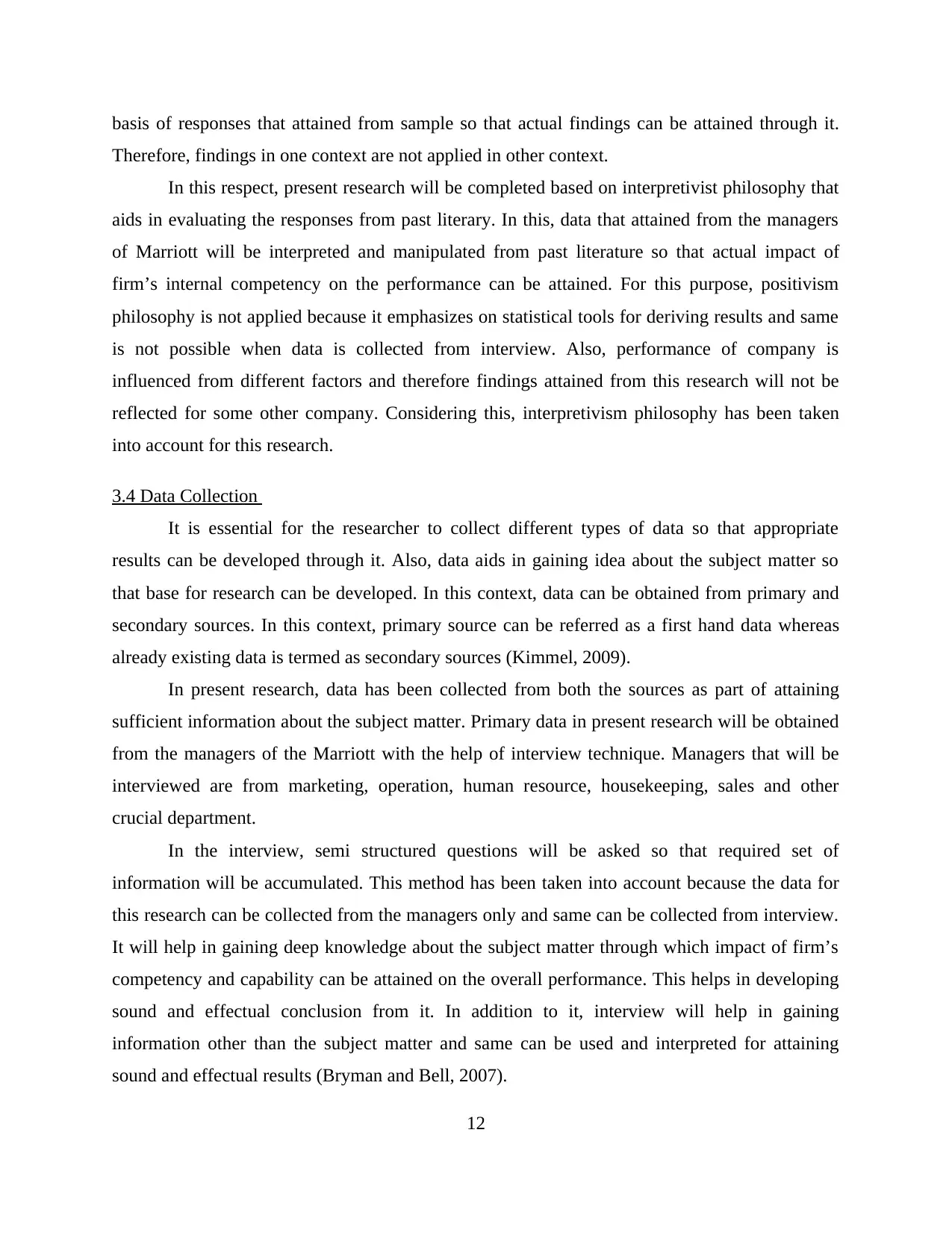
basis of responses that attained from sample so that actual findings can be attained through it.
Therefore, findings in one context are not applied in other context.
In this respect, present research will be completed based on interpretivist philosophy that
aids in evaluating the responses from past literary. In this, data that attained from the managers
of Marriott will be interpreted and manipulated from past literature so that actual impact of
firm’s internal competency on the performance can be attained. For this purpose, positivism
philosophy is not applied because it emphasizes on statistical tools for deriving results and same
is not possible when data is collected from interview. Also, performance of company is
influenced from different factors and therefore findings attained from this research will not be
reflected for some other company. Considering this, interpretivism philosophy has been taken
into account for this research.
3.4 Data Collection
It is essential for the researcher to collect different types of data so that appropriate
results can be developed through it. Also, data aids in gaining idea about the subject matter so
that base for research can be developed. In this context, data can be obtained from primary and
secondary sources. In this context, primary source can be referred as a first hand data whereas
already existing data is termed as secondary sources (Kimmel, 2009).
In present research, data has been collected from both the sources as part of attaining
sufficient information about the subject matter. Primary data in present research will be obtained
from the managers of the Marriott with the help of interview technique. Managers that will be
interviewed are from marketing, operation, human resource, housekeeping, sales and other
crucial department.
In the interview, semi structured questions will be asked so that required set of
information will be accumulated. This method has been taken into account because the data for
this research can be collected from the managers only and same can be collected from interview.
It will help in gaining deep knowledge about the subject matter through which impact of firm’s
competency and capability can be attained on the overall performance. This helps in developing
sound and effectual conclusion from it. In addition to it, interview will help in gaining
information other than the subject matter and same can be used and interpreted for attaining
sound and effectual results (Bryman and Bell, 2007).
12
Therefore, findings in one context are not applied in other context.
In this respect, present research will be completed based on interpretivist philosophy that
aids in evaluating the responses from past literary. In this, data that attained from the managers
of Marriott will be interpreted and manipulated from past literature so that actual impact of
firm’s internal competency on the performance can be attained. For this purpose, positivism
philosophy is not applied because it emphasizes on statistical tools for deriving results and same
is not possible when data is collected from interview. Also, performance of company is
influenced from different factors and therefore findings attained from this research will not be
reflected for some other company. Considering this, interpretivism philosophy has been taken
into account for this research.
3.4 Data Collection
It is essential for the researcher to collect different types of data so that appropriate
results can be developed through it. Also, data aids in gaining idea about the subject matter so
that base for research can be developed. In this context, data can be obtained from primary and
secondary sources. In this context, primary source can be referred as a first hand data whereas
already existing data is termed as secondary sources (Kimmel, 2009).
In present research, data has been collected from both the sources as part of attaining
sufficient information about the subject matter. Primary data in present research will be obtained
from the managers of the Marriott with the help of interview technique. Managers that will be
interviewed are from marketing, operation, human resource, housekeeping, sales and other
crucial department.
In the interview, semi structured questions will be asked so that required set of
information will be accumulated. This method has been taken into account because the data for
this research can be collected from the managers only and same can be collected from interview.
It will help in gaining deep knowledge about the subject matter through which impact of firm’s
competency and capability can be attained on the overall performance. This helps in developing
sound and effectual conclusion from it. In addition to it, interview will help in gaining
information other than the subject matter and same can be used and interpreted for attaining
sound and effectual results (Bryman and Bell, 2007).
12
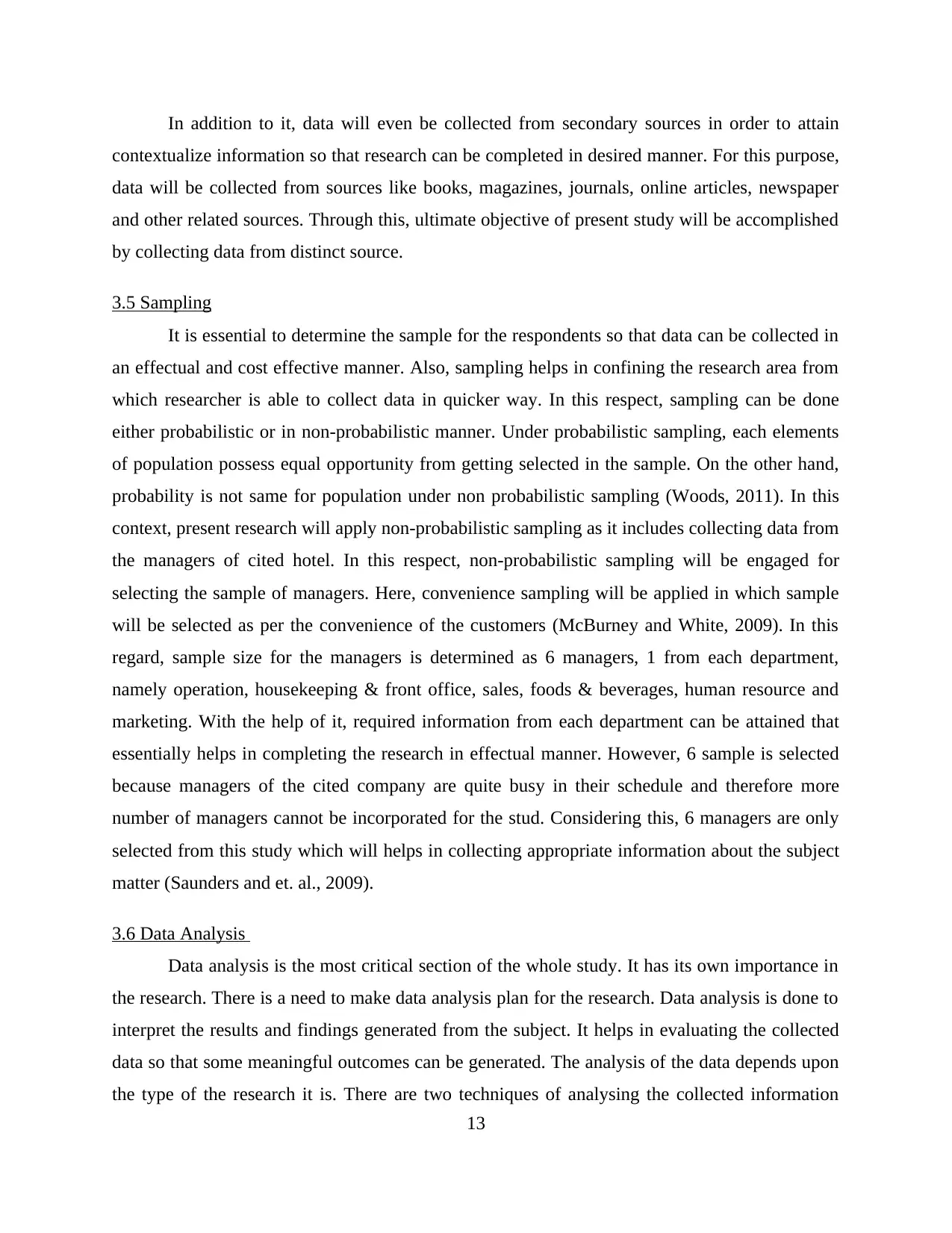
In addition to it, data will even be collected from secondary sources in order to attain
contextualize information so that research can be completed in desired manner. For this purpose,
data will be collected from sources like books, magazines, journals, online articles, newspaper
and other related sources. Through this, ultimate objective of present study will be accomplished
by collecting data from distinct source.
3.5 Sampling
It is essential to determine the sample for the respondents so that data can be collected in
an effectual and cost effective manner. Also, sampling helps in confining the research area from
which researcher is able to collect data in quicker way. In this respect, sampling can be done
either probabilistic or in non-probabilistic manner. Under probabilistic sampling, each elements
of population possess equal opportunity from getting selected in the sample. On the other hand,
probability is not same for population under non probabilistic sampling (Woods, 2011). In this
context, present research will apply non-probabilistic sampling as it includes collecting data from
the managers of cited hotel. In this respect, non-probabilistic sampling will be engaged for
selecting the sample of managers. Here, convenience sampling will be applied in which sample
will be selected as per the convenience of the customers (McBurney and White, 2009). In this
regard, sample size for the managers is determined as 6 managers, 1 from each department,
namely operation, housekeeping & front office, sales, foods & beverages, human resource and
marketing. With the help of it, required information from each department can be attained that
essentially helps in completing the research in effectual manner. However, 6 sample is selected
because managers of the cited company are quite busy in their schedule and therefore more
number of managers cannot be incorporated for the stud. Considering this, 6 managers are only
selected from this study which will helps in collecting appropriate information about the subject
matter (Saunders and et. al., 2009).
3.6 Data Analysis
Data analysis is the most critical section of the whole study. It has its own importance in
the research. There is a need to make data analysis plan for the research. Data analysis is done to
interpret the results and findings generated from the subject. It helps in evaluating the collected
data so that some meaningful outcomes can be generated. The analysis of the data depends upon
the type of the research it is. There are two techniques of analysing the collected information
13
contextualize information so that research can be completed in desired manner. For this purpose,
data will be collected from sources like books, magazines, journals, online articles, newspaper
and other related sources. Through this, ultimate objective of present study will be accomplished
by collecting data from distinct source.
3.5 Sampling
It is essential to determine the sample for the respondents so that data can be collected in
an effectual and cost effective manner. Also, sampling helps in confining the research area from
which researcher is able to collect data in quicker way. In this respect, sampling can be done
either probabilistic or in non-probabilistic manner. Under probabilistic sampling, each elements
of population possess equal opportunity from getting selected in the sample. On the other hand,
probability is not same for population under non probabilistic sampling (Woods, 2011). In this
context, present research will apply non-probabilistic sampling as it includes collecting data from
the managers of cited hotel. In this respect, non-probabilistic sampling will be engaged for
selecting the sample of managers. Here, convenience sampling will be applied in which sample
will be selected as per the convenience of the customers (McBurney and White, 2009). In this
regard, sample size for the managers is determined as 6 managers, 1 from each department,
namely operation, housekeeping & front office, sales, foods & beverages, human resource and
marketing. With the help of it, required information from each department can be attained that
essentially helps in completing the research in effectual manner. However, 6 sample is selected
because managers of the cited company are quite busy in their schedule and therefore more
number of managers cannot be incorporated for the stud. Considering this, 6 managers are only
selected from this study which will helps in collecting appropriate information about the subject
matter (Saunders and et. al., 2009).
3.6 Data Analysis
Data analysis is the most critical section of the whole study. It has its own importance in
the research. There is a need to make data analysis plan for the research. Data analysis is done to
interpret the results and findings generated from the subject. It helps in evaluating the collected
data so that some meaningful outcomes can be generated. The analysis of the data depends upon
the type of the research it is. There are two techniques of analysing the collected information
13
Secure Best Marks with AI Grader
Need help grading? Try our AI Grader for instant feedback on your assignments.
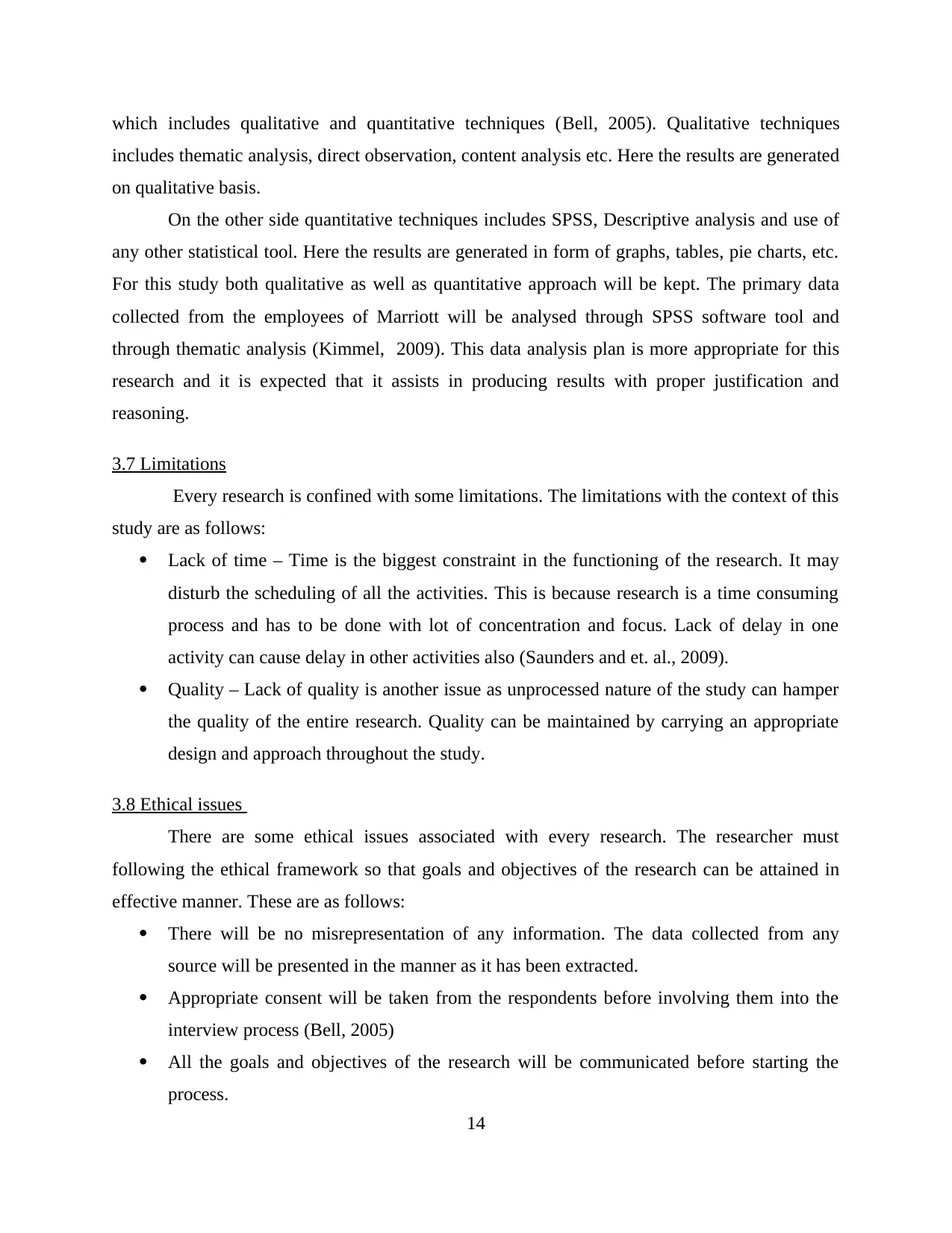
which includes qualitative and quantitative techniques (Bell, 2005). Qualitative techniques
includes thematic analysis, direct observation, content analysis etc. Here the results are generated
on qualitative basis.
On the other side quantitative techniques includes SPSS, Descriptive analysis and use of
any other statistical tool. Here the results are generated in form of graphs, tables, pie charts, etc.
For this study both qualitative as well as quantitative approach will be kept. The primary data
collected from the employees of Marriott will be analysed through SPSS software tool and
through thematic analysis (Kimmel, 2009). This data analysis plan is more appropriate for this
research and it is expected that it assists in producing results with proper justification and
reasoning.
3.7 Limitations
Every research is confined with some limitations. The limitations with the context of this
study are as follows:
Lack of time – Time is the biggest constraint in the functioning of the research. It may
disturb the scheduling of all the activities. This is because research is a time consuming
process and has to be done with lot of concentration and focus. Lack of delay in one
activity can cause delay in other activities also (Saunders and et. al., 2009).
Quality – Lack of quality is another issue as unprocessed nature of the study can hamper
the quality of the entire research. Quality can be maintained by carrying an appropriate
design and approach throughout the study.
3.8 Ethical issues
There are some ethical issues associated with every research. The researcher must
following the ethical framework so that goals and objectives of the research can be attained in
effective manner. These are as follows:
There will be no misrepresentation of any information. The data collected from any
source will be presented in the manner as it has been extracted.
Appropriate consent will be taken from the respondents before involving them into the
interview process (Bell, 2005)
All the goals and objectives of the research will be communicated before starting the
process.
14
includes thematic analysis, direct observation, content analysis etc. Here the results are generated
on qualitative basis.
On the other side quantitative techniques includes SPSS, Descriptive analysis and use of
any other statistical tool. Here the results are generated in form of graphs, tables, pie charts, etc.
For this study both qualitative as well as quantitative approach will be kept. The primary data
collected from the employees of Marriott will be analysed through SPSS software tool and
through thematic analysis (Kimmel, 2009). This data analysis plan is more appropriate for this
research and it is expected that it assists in producing results with proper justification and
reasoning.
3.7 Limitations
Every research is confined with some limitations. The limitations with the context of this
study are as follows:
Lack of time – Time is the biggest constraint in the functioning of the research. It may
disturb the scheduling of all the activities. This is because research is a time consuming
process and has to be done with lot of concentration and focus. Lack of delay in one
activity can cause delay in other activities also (Saunders and et. al., 2009).
Quality – Lack of quality is another issue as unprocessed nature of the study can hamper
the quality of the entire research. Quality can be maintained by carrying an appropriate
design and approach throughout the study.
3.8 Ethical issues
There are some ethical issues associated with every research. The researcher must
following the ethical framework so that goals and objectives of the research can be attained in
effective manner. These are as follows:
There will be no misrepresentation of any information. The data collected from any
source will be presented in the manner as it has been extracted.
Appropriate consent will be taken from the respondents before involving them into the
interview process (Bell, 2005)
All the goals and objectives of the research will be communicated before starting the
process.
14
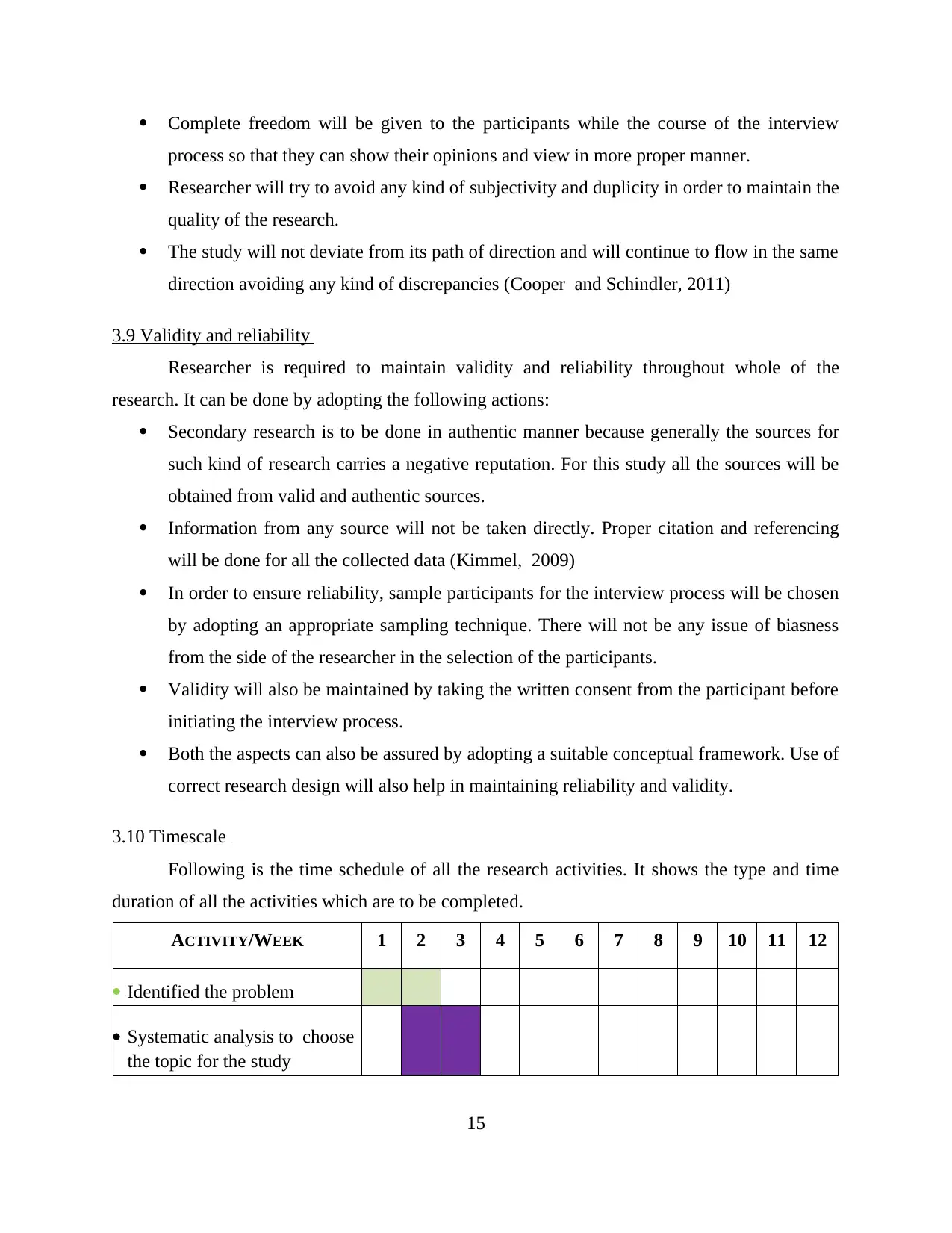
Complete freedom will be given to the participants while the course of the interview
process so that they can show their opinions and view in more proper manner.
Researcher will try to avoid any kind of subjectivity and duplicity in order to maintain the
quality of the research.
The study will not deviate from its path of direction and will continue to flow in the same
direction avoiding any kind of discrepancies (Cooper and Schindler, 2011)
3.9 Validity and reliability
Researcher is required to maintain validity and reliability throughout whole of the
research. It can be done by adopting the following actions:
Secondary research is to be done in authentic manner because generally the sources for
such kind of research carries a negative reputation. For this study all the sources will be
obtained from valid and authentic sources.
Information from any source will not be taken directly. Proper citation and referencing
will be done for all the collected data (Kimmel, 2009)
In order to ensure reliability, sample participants for the interview process will be chosen
by adopting an appropriate sampling technique. There will not be any issue of biasness
from the side of the researcher in the selection of the participants.
Validity will also be maintained by taking the written consent from the participant before
initiating the interview process.
Both the aspects can also be assured by adopting a suitable conceptual framework. Use of
correct research design will also help in maintaining reliability and validity.
3.10 Timescale
Following is the time schedule of all the research activities. It shows the type and time
duration of all the activities which are to be completed.
ACTIVITY/WEEK 1 2 3 4 5 6 7 8 9 10 11 12
Identified the problem
Systematic analysis to choose
the topic for the study
15
process so that they can show their opinions and view in more proper manner.
Researcher will try to avoid any kind of subjectivity and duplicity in order to maintain the
quality of the research.
The study will not deviate from its path of direction and will continue to flow in the same
direction avoiding any kind of discrepancies (Cooper and Schindler, 2011)
3.9 Validity and reliability
Researcher is required to maintain validity and reliability throughout whole of the
research. It can be done by adopting the following actions:
Secondary research is to be done in authentic manner because generally the sources for
such kind of research carries a negative reputation. For this study all the sources will be
obtained from valid and authentic sources.
Information from any source will not be taken directly. Proper citation and referencing
will be done for all the collected data (Kimmel, 2009)
In order to ensure reliability, sample participants for the interview process will be chosen
by adopting an appropriate sampling technique. There will not be any issue of biasness
from the side of the researcher in the selection of the participants.
Validity will also be maintained by taking the written consent from the participant before
initiating the interview process.
Both the aspects can also be assured by adopting a suitable conceptual framework. Use of
correct research design will also help in maintaining reliability and validity.
3.10 Timescale
Following is the time schedule of all the research activities. It shows the type and time
duration of all the activities which are to be completed.
ACTIVITY/WEEK 1 2 3 4 5 6 7 8 9 10 11 12
Identified the problem
Systematic analysis to choose
the topic for the study
15
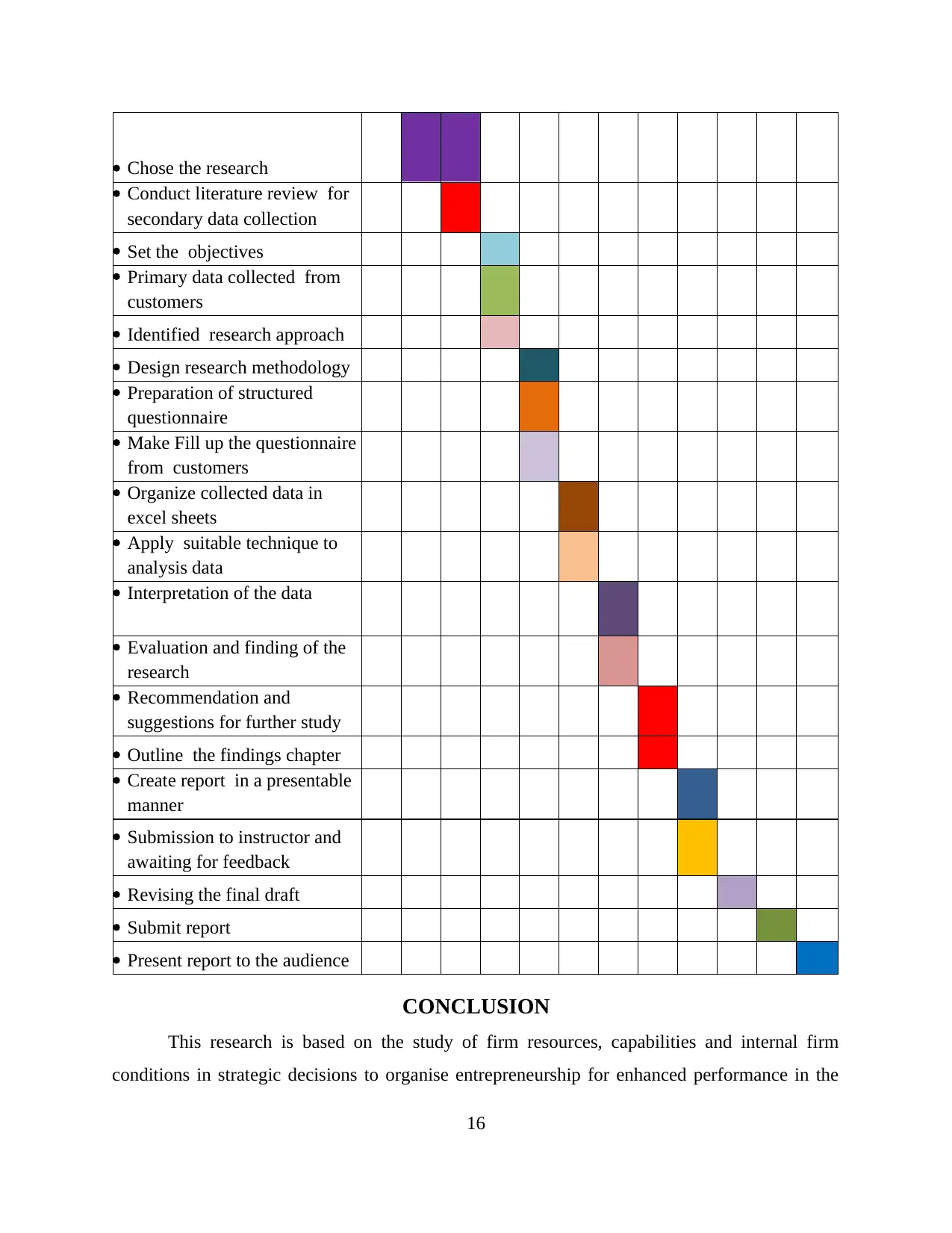
Chose the research
Conduct literature review for
secondary data collection
Set the objectives
Primary data collected from
customers
Identified research approach
Design research methodology
Preparation of structured
questionnaire
Make Fill up the questionnaire
from customers
Organize collected data in
excel sheets
Apply suitable technique to
analysis data
Interpretation of the data
Evaluation and finding of the
research
Recommendation and
suggestions for further study
Outline the findings chapter
Create report in a presentable
manner
Submission to instructor and
awaiting for feedback
Revising the final draft
Submit report
Present report to the audience
CONCLUSION
This research is based on the study of firm resources, capabilities and internal firm
conditions in strategic decisions to organise entrepreneurship for enhanced performance in the
16
Conduct literature review for
secondary data collection
Set the objectives
Primary data collected from
customers
Identified research approach
Design research methodology
Preparation of structured
questionnaire
Make Fill up the questionnaire
from customers
Organize collected data in
excel sheets
Apply suitable technique to
analysis data
Interpretation of the data
Evaluation and finding of the
research
Recommendation and
suggestions for further study
Outline the findings chapter
Create report in a presentable
manner
Submission to instructor and
awaiting for feedback
Revising the final draft
Submit report
Present report to the audience
CONCLUSION
This research is based on the study of firm resources, capabilities and internal firm
conditions in strategic decisions to organise entrepreneurship for enhanced performance in the
16
Paraphrase This Document
Need a fresh take? Get an instant paraphrase of this document with our AI Paraphraser
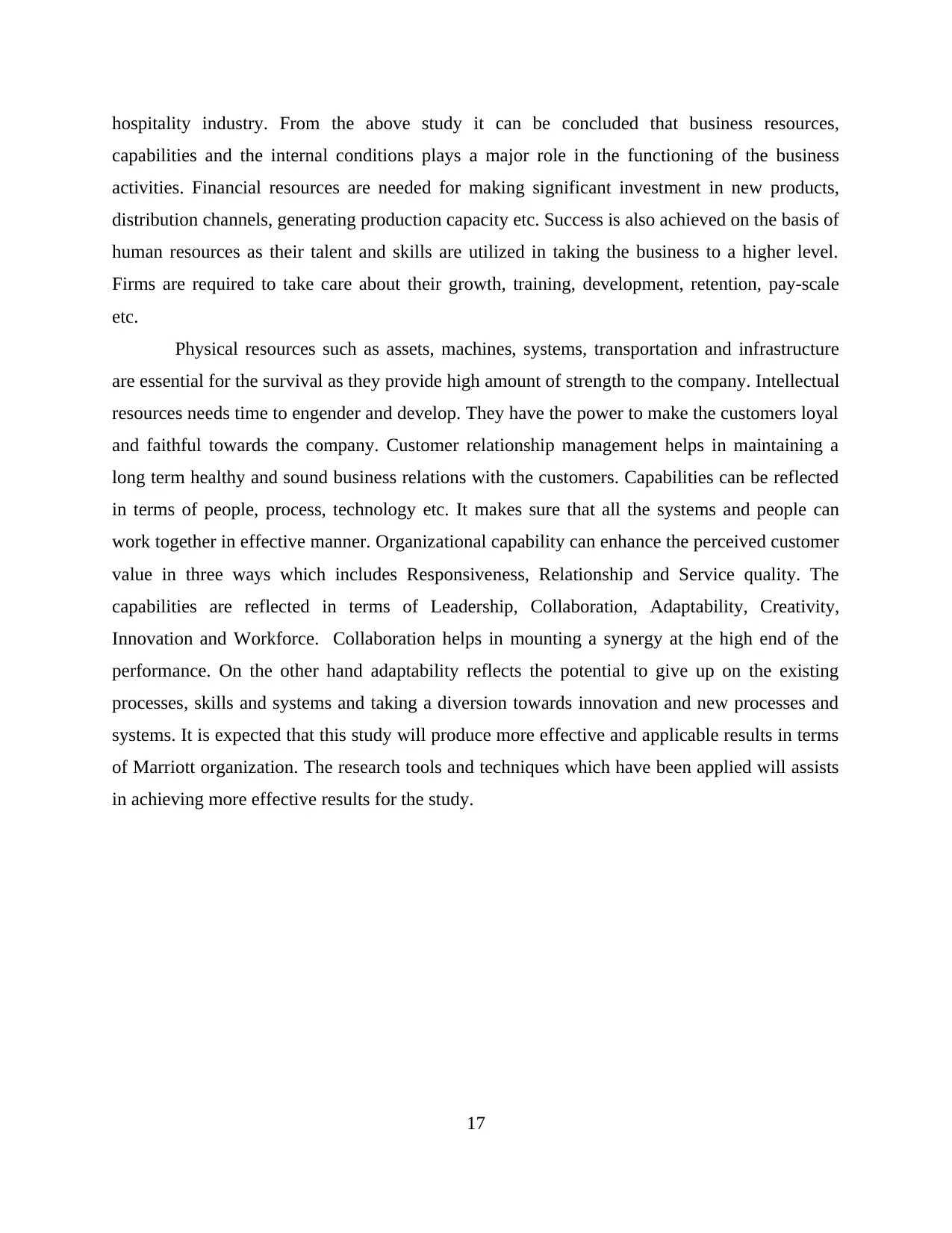
hospitality industry. From the above study it can be concluded that business resources,
capabilities and the internal conditions plays a major role in the functioning of the business
activities. Financial resources are needed for making significant investment in new products,
distribution channels, generating production capacity etc. Success is also achieved on the basis of
human resources as their talent and skills are utilized in taking the business to a higher level.
Firms are required to take care about their growth, training, development, retention, pay-scale
etc.
Physical resources such as assets, machines, systems, transportation and infrastructure
are essential for the survival as they provide high amount of strength to the company. Intellectual
resources needs time to engender and develop. They have the power to make the customers loyal
and faithful towards the company. Customer relationship management helps in maintaining a
long term healthy and sound business relations with the customers. Capabilities can be reflected
in terms of people, process, technology etc. It makes sure that all the systems and people can
work together in effective manner. Organizational capability can enhance the perceived customer
value in three ways which includes Responsiveness, Relationship and Service quality. The
capabilities are reflected in terms of Leadership, Collaboration, Adaptability, Creativity,
Innovation and Workforce. Collaboration helps in mounting a synergy at the high end of the
performance. On the other hand adaptability reflects the potential to give up on the existing
processes, skills and systems and taking a diversion towards innovation and new processes and
systems. It is expected that this study will produce more effective and applicable results in terms
of Marriott organization. The research tools and techniques which have been applied will assists
in achieving more effective results for the study.
17
capabilities and the internal conditions plays a major role in the functioning of the business
activities. Financial resources are needed for making significant investment in new products,
distribution channels, generating production capacity etc. Success is also achieved on the basis of
human resources as their talent and skills are utilized in taking the business to a higher level.
Firms are required to take care about their growth, training, development, retention, pay-scale
etc.
Physical resources such as assets, machines, systems, transportation and infrastructure
are essential for the survival as they provide high amount of strength to the company. Intellectual
resources needs time to engender and develop. They have the power to make the customers loyal
and faithful towards the company. Customer relationship management helps in maintaining a
long term healthy and sound business relations with the customers. Capabilities can be reflected
in terms of people, process, technology etc. It makes sure that all the systems and people can
work together in effective manner. Organizational capability can enhance the perceived customer
value in three ways which includes Responsiveness, Relationship and Service quality. The
capabilities are reflected in terms of Leadership, Collaboration, Adaptability, Creativity,
Innovation and Workforce. Collaboration helps in mounting a synergy at the high end of the
performance. On the other hand adaptability reflects the potential to give up on the existing
processes, skills and systems and taking a diversion towards innovation and new processes and
systems. It is expected that this study will produce more effective and applicable results in terms
of Marriott organization. The research tools and techniques which have been applied will assists
in achieving more effective results for the study.
17
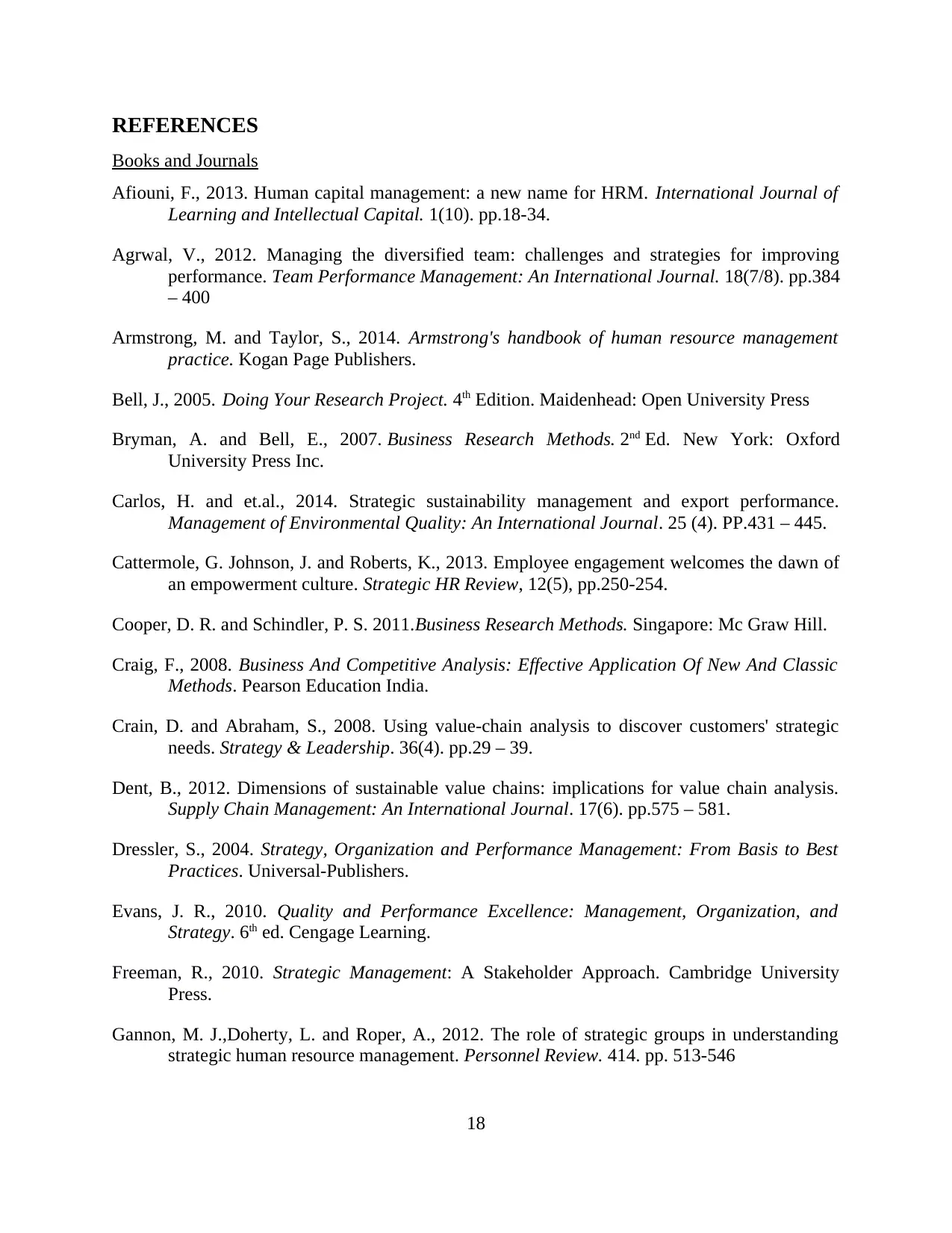
REFERENCES
Books and Journals
Afiouni, F., 2013. Human capital management: a new name for HRM. International Journal of
Learning and Intellectual Capital. 1(10). pp.18-34.
Agrwal, V., 2012. Managing the diversified team: challenges and strategies for improving
performance. Team Performance Management: An International Journal. 18(7/8). pp.384
– 400
Armstrong, M. and Taylor, S., 2014. Armstrong's handbook of human resource management
practice. Kogan Page Publishers.
Bell, J., 2005. Doing Your Research Project. 4th Edition. Maidenhead: Open University Press
Bryman, A. and Bell, E., 2007. Business Research Methods. 2nd Ed. New York: Oxford
University Press Inc.
Carlos, H. and et.al., 2014. Strategic sustainability management and export performance.
Management of Environmental Quality: An International Journal. 25 (4). PP.431 – 445.
Cattermole, G. Johnson, J. and Roberts, K., 2013. Employee engagement welcomes the dawn of
an empowerment culture. Strategic HR Review, 12(5), pp.250-254.
Cooper, D. R. and Schindler, P. S. 2011.Business Research Methods. Singapore: Mc Graw Hill.
Craig, F., 2008. Business And Competitive Analysis: Effective Application Of New And Classic
Methods. Pearson Education India.
Crain, D. and Abraham, S., 2008. Using value-chain analysis to discover customers' strategic
needs. Strategy & Leadership. 36(4). pp.29 – 39.
Dent, B., 2012. Dimensions of sustainable value chains: implications for value chain analysis.
Supply Chain Management: An International Journal. 17(6). pp.575 – 581.
Dressler, S., 2004. Strategy, Organization and Performance Management: From Basis to Best
Practices. Universal-Publishers.
Evans, J. R., 2010. Quality and Performance Excellence: Management, Organization, and
Strategy. 6th ed. Cengage Learning.
Freeman, R., 2010. Strategic Management: A Stakeholder Approach. Cambridge University
Press.
Gannon, M. J.,Doherty, L. and Roper, A., 2012. The role of strategic groups in understanding
strategic human resource management. Personnel Review. 414. pp. 513-546
18
Books and Journals
Afiouni, F., 2013. Human capital management: a new name for HRM. International Journal of
Learning and Intellectual Capital. 1(10). pp.18-34.
Agrwal, V., 2012. Managing the diversified team: challenges and strategies for improving
performance. Team Performance Management: An International Journal. 18(7/8). pp.384
– 400
Armstrong, M. and Taylor, S., 2014. Armstrong's handbook of human resource management
practice. Kogan Page Publishers.
Bell, J., 2005. Doing Your Research Project. 4th Edition. Maidenhead: Open University Press
Bryman, A. and Bell, E., 2007. Business Research Methods. 2nd Ed. New York: Oxford
University Press Inc.
Carlos, H. and et.al., 2014. Strategic sustainability management and export performance.
Management of Environmental Quality: An International Journal. 25 (4). PP.431 – 445.
Cattermole, G. Johnson, J. and Roberts, K., 2013. Employee engagement welcomes the dawn of
an empowerment culture. Strategic HR Review, 12(5), pp.250-254.
Cooper, D. R. and Schindler, P. S. 2011.Business Research Methods. Singapore: Mc Graw Hill.
Craig, F., 2008. Business And Competitive Analysis: Effective Application Of New And Classic
Methods. Pearson Education India.
Crain, D. and Abraham, S., 2008. Using value-chain analysis to discover customers' strategic
needs. Strategy & Leadership. 36(4). pp.29 – 39.
Dent, B., 2012. Dimensions of sustainable value chains: implications for value chain analysis.
Supply Chain Management: An International Journal. 17(6). pp.575 – 581.
Dressler, S., 2004. Strategy, Organization and Performance Management: From Basis to Best
Practices. Universal-Publishers.
Evans, J. R., 2010. Quality and Performance Excellence: Management, Organization, and
Strategy. 6th ed. Cengage Learning.
Freeman, R., 2010. Strategic Management: A Stakeholder Approach. Cambridge University
Press.
Gannon, M. J.,Doherty, L. and Roper, A., 2012. The role of strategic groups in understanding
strategic human resource management. Personnel Review. 414. pp. 513-546
18
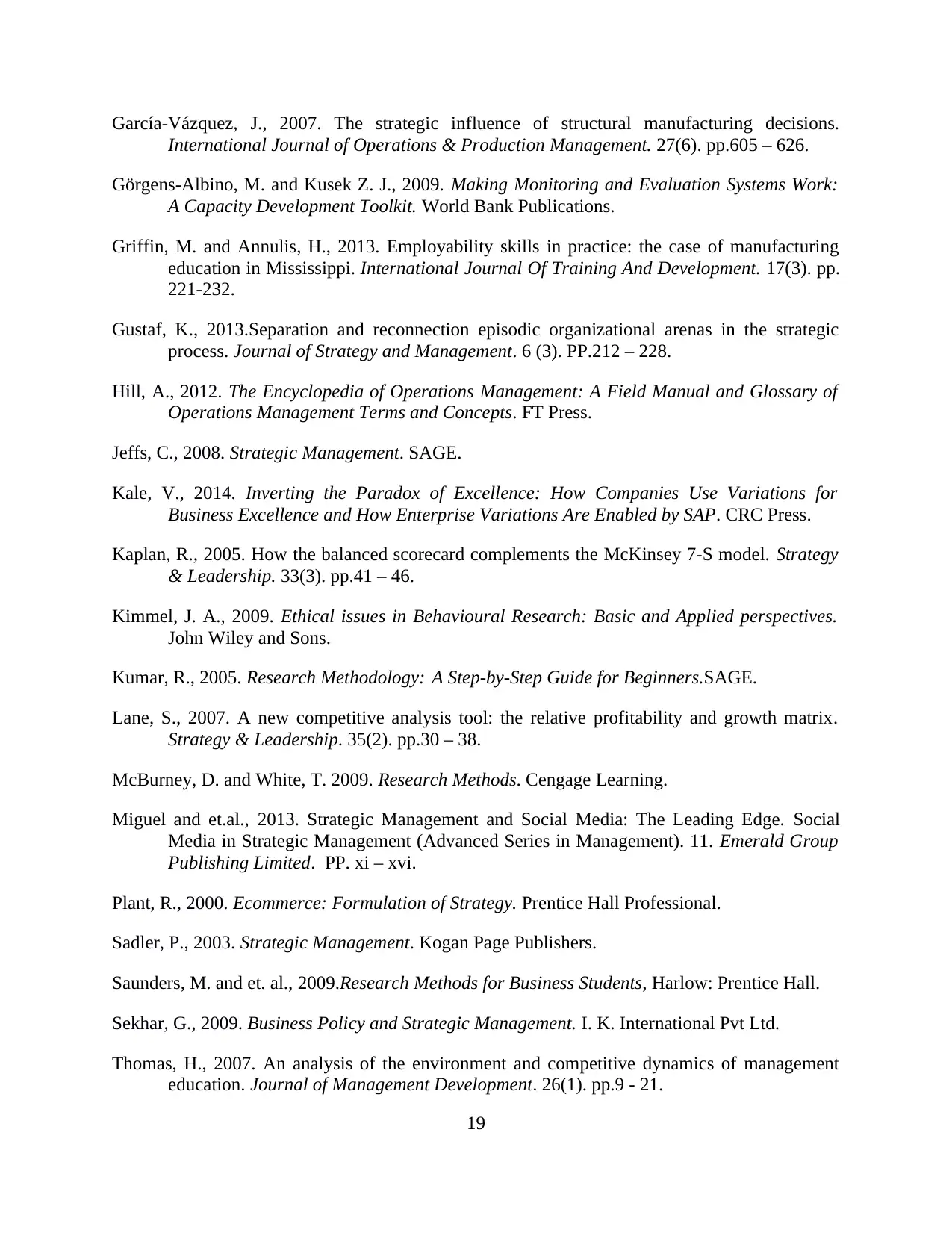
García-Vázquez, J., 2007. The strategic influence of structural manufacturing decisions.
International Journal of Operations & Production Management. 27(6). pp.605 – 626.
Görgens-Albino, M. and Kusek Z. J., 2009. Making Monitoring and Evaluation Systems Work:
A Capacity Development Toolkit. World Bank Publications.
Griffin, M. and Annulis, H., 2013. Employability skills in practice: the case of manufacturing
education in Mississippi. International Journal Of Training And Development. 17(3). pp.
221-232.
Gustaf, K., 2013.Separation and reconnection episodic organizational arenas in the strategic
process. Journal of Strategy and Management. 6 (3). PP.212 – 228.
Hill, A., 2012. The Encyclopedia of Operations Management: A Field Manual and Glossary of
Operations Management Terms and Concepts. FT Press.
Jeffs, C., 2008. Strategic Management. SAGE.
Kale, V., 2014. Inverting the Paradox of Excellence: How Companies Use Variations for
Business Excellence and How Enterprise Variations Are Enabled by SAP. CRC Press.
Kaplan, R., 2005. How the balanced scorecard complements the McKinsey 7-S model. Strategy
& Leadership. 33(3). pp.41 – 46.
Kimmel, J. A., 2009. Ethical issues in Behavioural Research: Basic and Applied perspectives.
John Wiley and Sons.
Kumar, R., 2005. Research Methodology: A Step-by-Step Guide for Beginners.SAGE.
Lane, S., 2007. A new competitive analysis tool: the relative profitability and growth matrix.
Strategy & Leadership. 35(2). pp.30 – 38.
McBurney, D. and White, T. 2009. Research Methods. Cengage Learning.
Miguel and et.al., 2013. Strategic Management and Social Media: The Leading Edge. Social
Media in Strategic Management (Advanced Series in Management). 11. Emerald Group
Publishing Limited. PP. xi – xvi.
Plant, R., 2000. Ecommerce: Formulation of Strategy. Prentice Hall Professional.
Sadler, P., 2003. Strategic Management. Kogan Page Publishers.
Saunders, M. and et. al., 2009.Research Methods for Business Students, Harlow: Prentice Hall.
Sekhar, G., 2009. Business Policy and Strategic Management. I. K. International Pvt Ltd.
Thomas, H., 2007. An analysis of the environment and competitive dynamics of management
education. Journal of Management Development. 26(1). pp.9 - 21.
19
International Journal of Operations & Production Management. 27(6). pp.605 – 626.
Görgens-Albino, M. and Kusek Z. J., 2009. Making Monitoring and Evaluation Systems Work:
A Capacity Development Toolkit. World Bank Publications.
Griffin, M. and Annulis, H., 2013. Employability skills in practice: the case of manufacturing
education in Mississippi. International Journal Of Training And Development. 17(3). pp.
221-232.
Gustaf, K., 2013.Separation and reconnection episodic organizational arenas in the strategic
process. Journal of Strategy and Management. 6 (3). PP.212 – 228.
Hill, A., 2012. The Encyclopedia of Operations Management: A Field Manual and Glossary of
Operations Management Terms and Concepts. FT Press.
Jeffs, C., 2008. Strategic Management. SAGE.
Kale, V., 2014. Inverting the Paradox of Excellence: How Companies Use Variations for
Business Excellence and How Enterprise Variations Are Enabled by SAP. CRC Press.
Kaplan, R., 2005. How the balanced scorecard complements the McKinsey 7-S model. Strategy
& Leadership. 33(3). pp.41 – 46.
Kimmel, J. A., 2009. Ethical issues in Behavioural Research: Basic and Applied perspectives.
John Wiley and Sons.
Kumar, R., 2005. Research Methodology: A Step-by-Step Guide for Beginners.SAGE.
Lane, S., 2007. A new competitive analysis tool: the relative profitability and growth matrix.
Strategy & Leadership. 35(2). pp.30 – 38.
McBurney, D. and White, T. 2009. Research Methods. Cengage Learning.
Miguel and et.al., 2013. Strategic Management and Social Media: The Leading Edge. Social
Media in Strategic Management (Advanced Series in Management). 11. Emerald Group
Publishing Limited. PP. xi – xvi.
Plant, R., 2000. Ecommerce: Formulation of Strategy. Prentice Hall Professional.
Sadler, P., 2003. Strategic Management. Kogan Page Publishers.
Saunders, M. and et. al., 2009.Research Methods for Business Students, Harlow: Prentice Hall.
Sekhar, G., 2009. Business Policy and Strategic Management. I. K. International Pvt Ltd.
Thomas, H., 2007. An analysis of the environment and competitive dynamics of management
education. Journal of Management Development. 26(1). pp.9 - 21.
19
Secure Best Marks with AI Grader
Need help grading? Try our AI Grader for instant feedback on your assignments.
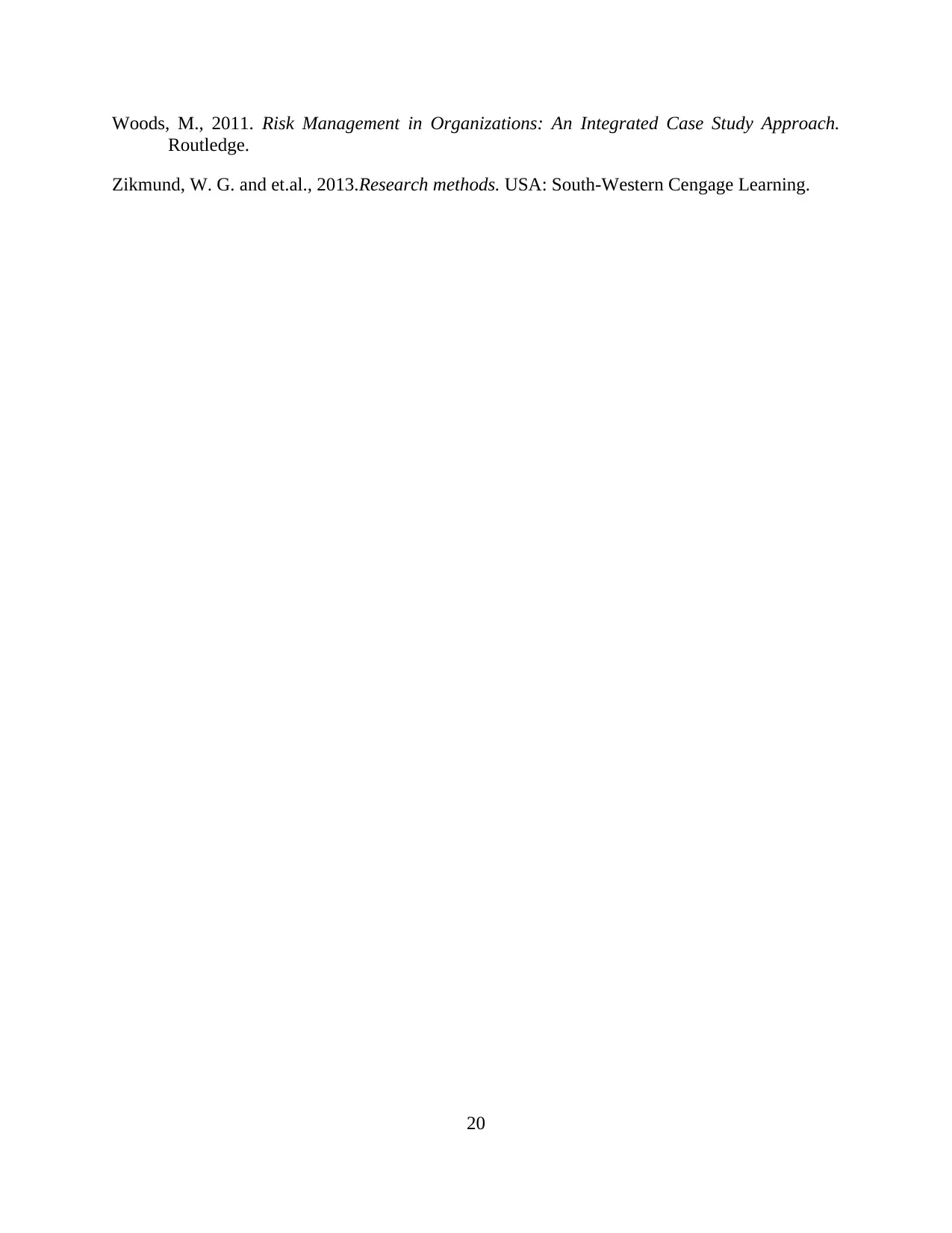
Woods, M., 2011. Risk Management in Organizations: An Integrated Case Study Approach.
Routledge.
Zikmund, W. G. and et.al., 2013.Research methods. USA: South-Western Cengage Learning.
20
Routledge.
Zikmund, W. G. and et.al., 2013.Research methods. USA: South-Western Cengage Learning.
20
1 out of 23
Related Documents
Your All-in-One AI-Powered Toolkit for Academic Success.
+13062052269
info@desklib.com
Available 24*7 on WhatsApp / Email
![[object Object]](/_next/static/media/star-bottom.7253800d.svg)
Unlock your academic potential
© 2024 | Zucol Services PVT LTD | All rights reserved.





